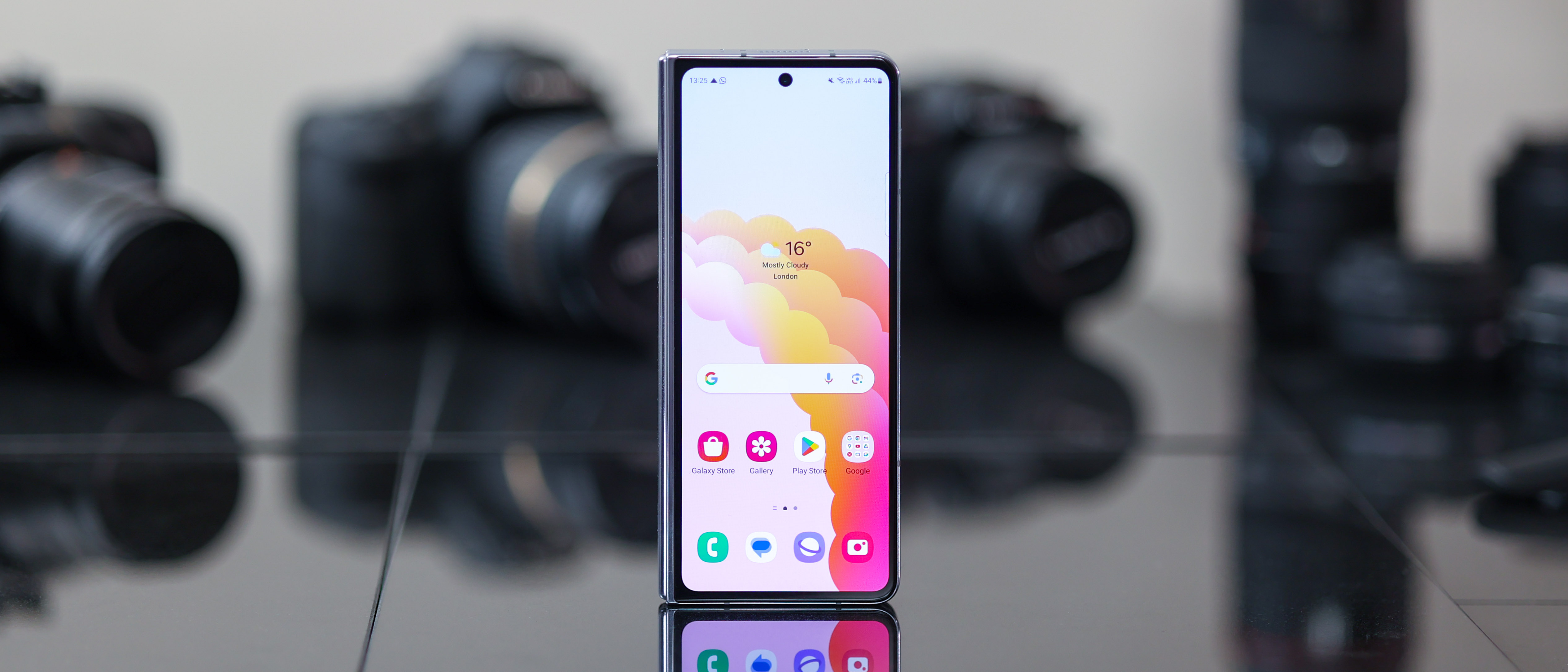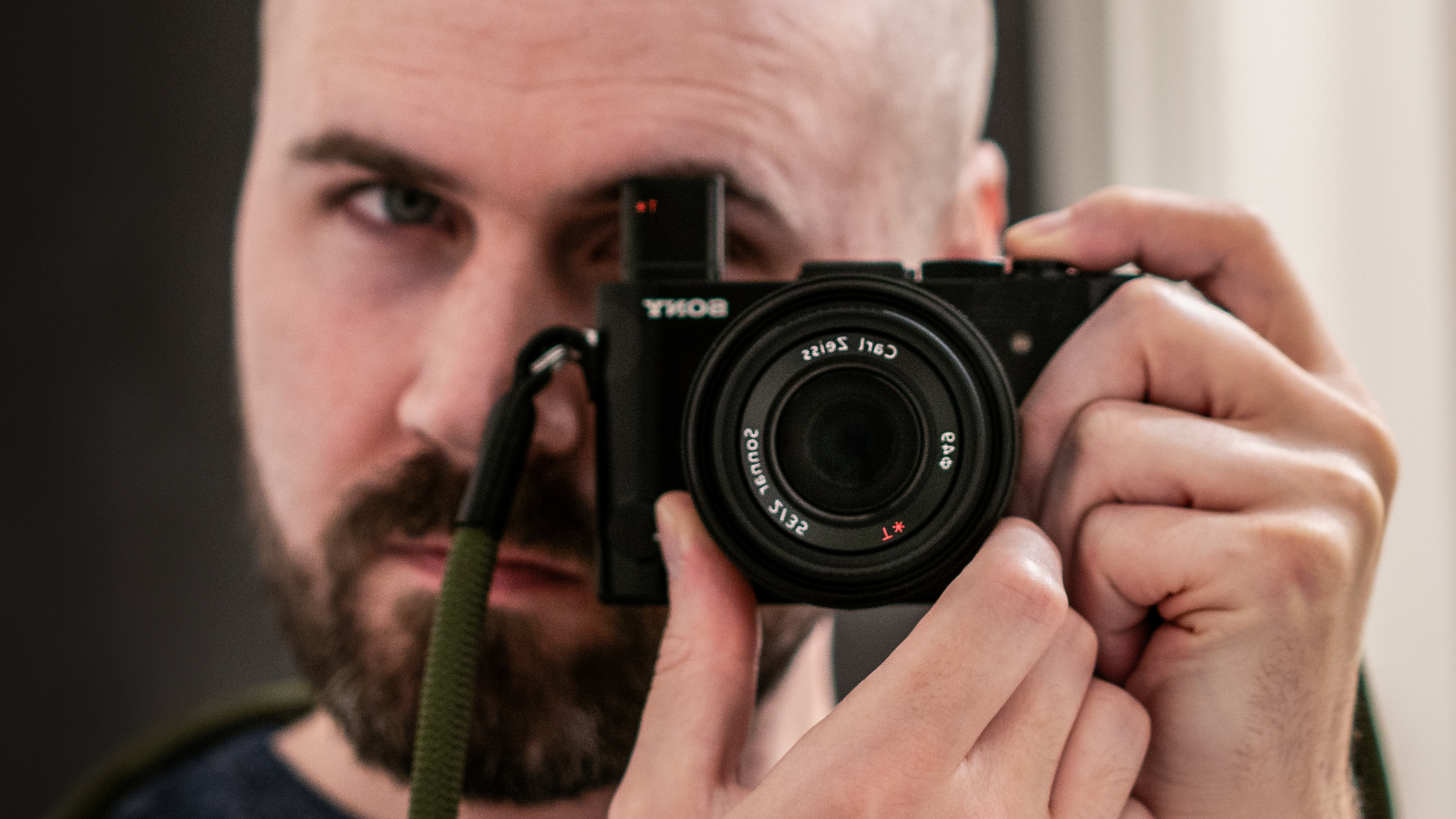Digital Camera World Verdict
Book-style, big-screened folding phones are niche, expensive, and the choice is limited for anyone who lives in the West. With that in mind, the Galaxy Z Fold 5 is the best around, with its solid hinge, good-enough camera, ample power, decent battery life, and S Pen support. What sets it apart from the competition is how well the interface is optimized for its folding form. While it isn't worth an upgrade from the Z Fold 3 or 4, therefore, it could be a smart first foldable.
Pros
- +
Foldable optimized interface
- +
Great S Pen support
- +
Solid-feeling hinge
- +
IPX8 water resistant
Cons
- -
Heavy photo processing
- -
Cramped cover screen
- -
Visible screen crease
- -
Very expensive
Why you can trust Digital Camera World
Just a few months after the Google Pixel Fold laid down the gauntlet to challenge Samsung's domination of foldables, Samsung unveiled its 2023 line of folding phones, with its Galaxy Z Fold 5 leading the charge, alongside the Z Flip 5.
There are plenty of exciting, cutting-edge big-screened foldable phones in China – the Honor Magic V2, Oppo Find N2, and Xiaomi Mix Fold 3 – but Samsung's Galaxy Z Fold-series hasn't had as much competition in the West.
Recent Western releases like the Honor Magic Vs, Huawei Mate X3, and Google Pixel Fold – the only one of the three available in the US – indicate the tides are turning. But no phone has pushed Samsung off the top spot since it dropped the first Galaxy Fold in 2019. And that's despite the fact the Z Fold line hasn't historically had great cameras for the price.
• Read our guide to the best Android phones
As it happens, photography fans thinking of buying a foldable face an uphill battle when it comes to camera quality, whichever phone they go for. All folding phones are hamstrung by size; squeezing two screens into a pocketable package doesn't leave much room for top-notch camera hardware.
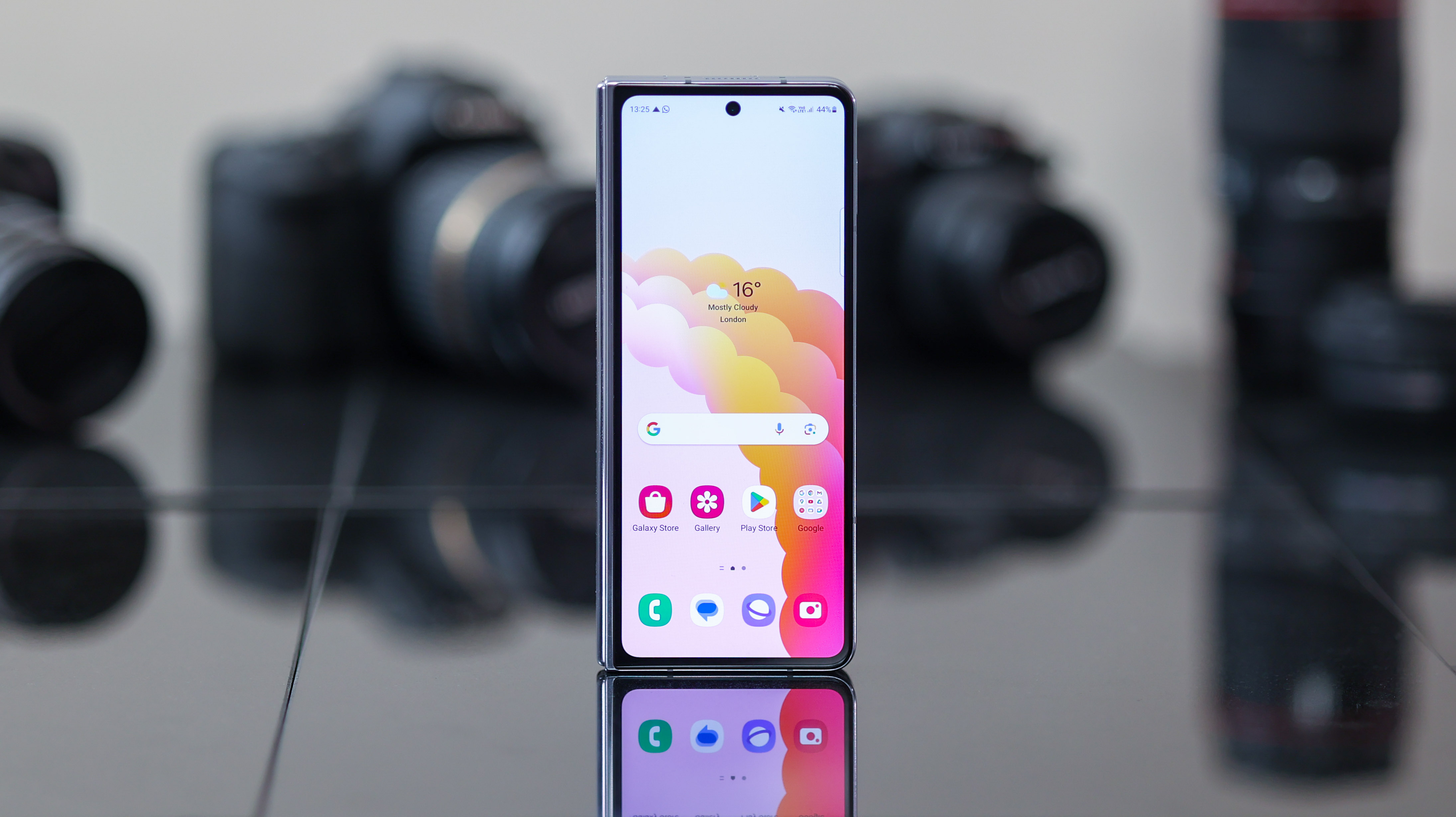
So while top-tier camera phones like the Galaxy S23 Ultra are riding high with big camera sensors and far-reaching optics, we've yet to see an uncompromising foldable camera phone. And the Z Fold 5 doesn't change that fact.
After all, Samsung hasn't made any significant camera upgrades this year. It's closed its hinge gap – making its inner screen less exposed to grit and dust – the internals have been refreshed, the S Pen is now water-resistant, and it has a better big-screen interface. But its camera is the same set-up we saw on the Z Fold 4.
Despite its limitations, though, the Samsung Galaxy Z Fold 5 is still a lesson in how to make a best-of-the-bunch book-style folding phone in 2023; here's why...
Samsung Galaxy Z Fold 5 Review: Design
From a distance, you would be hard-pressed to spot the difference between the Z Fold 4 and Z Fold 5, but if you get down to the specs, the 2023 Z Fold 5 is thinner and lighter and ditches the hinge gap.
Weighing 253g, the Z Fold 5 is 10g lighter than the Fold 4, and at 13.4mm when closed, it's also 2.4mm thinner. How does this stack up against other foldables? Pretty well, actually – the Fold 5 sits at around the middle of the pack – with the heavier Honor Magic Vs weighing 267g, and the Pixel Fold clocking in at a beefy 283g.
The only lighter book-style foldable in the West is the Huawei Mate X3 which weighs 239g, while the China-only Oppo Find N2 also weighs 239g – that's 1g lighter than an iPhone 14 Pro Max (240g).
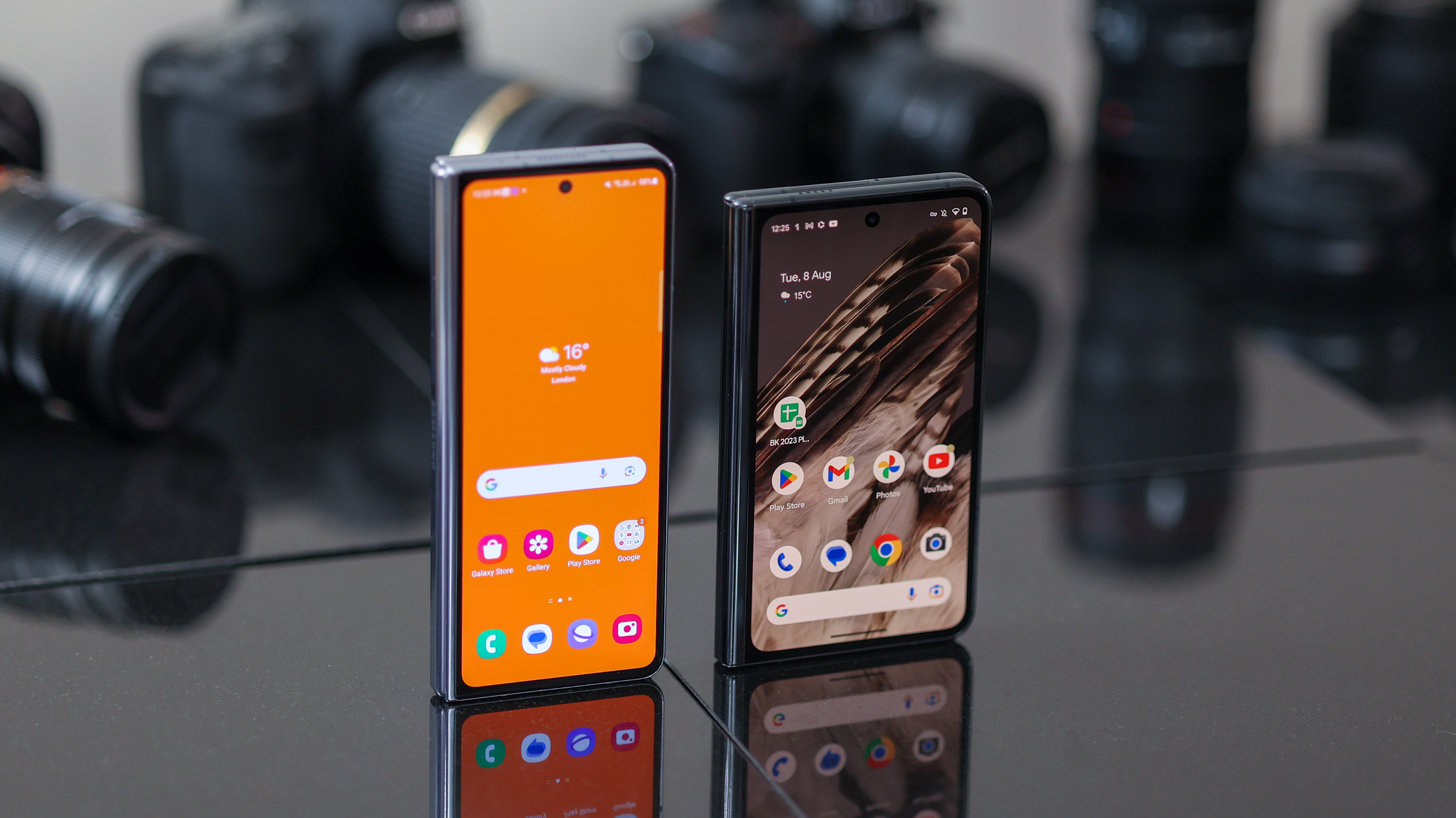
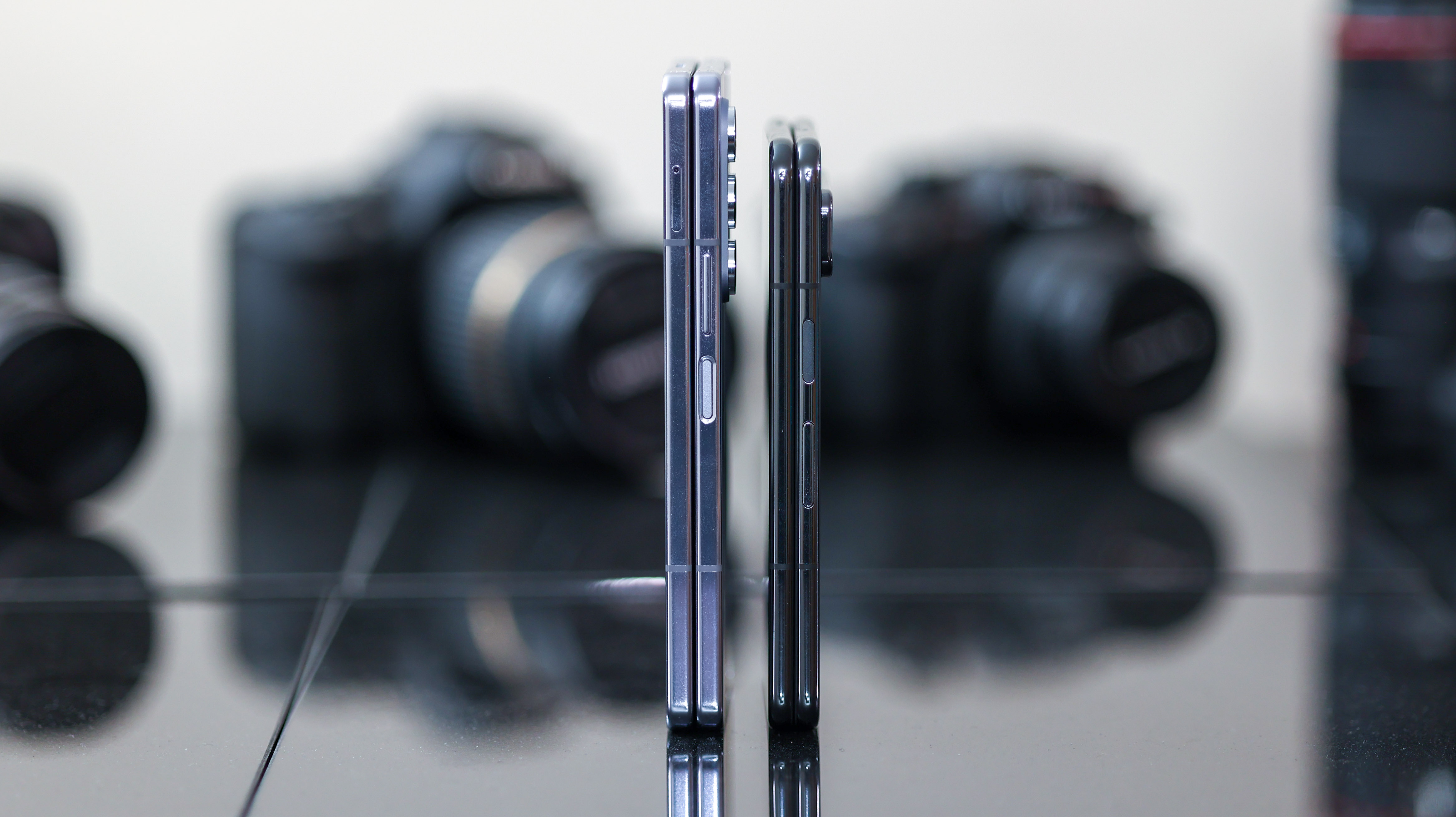
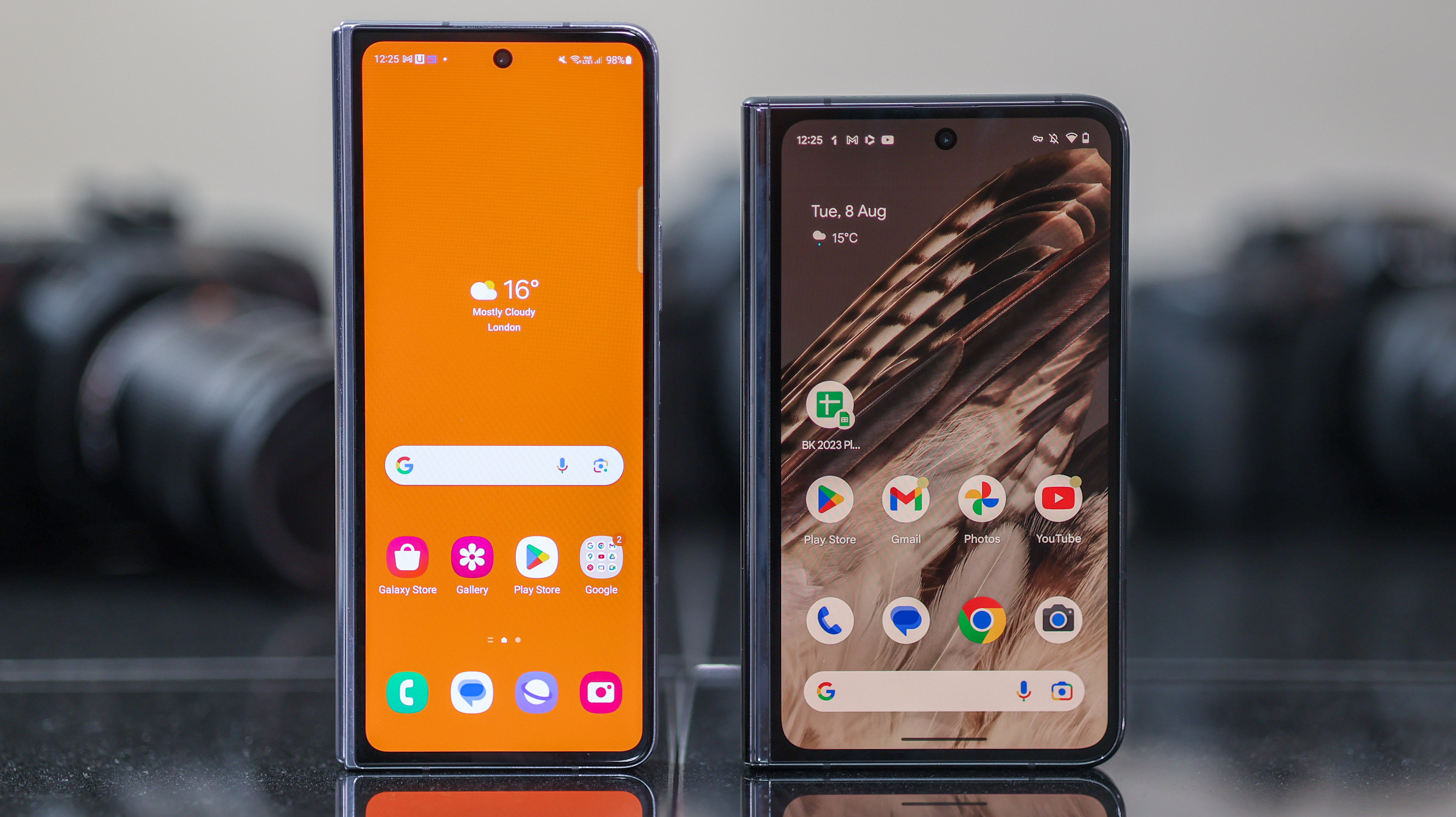
The Galaxy Z Fold 5's frame is made of Samsung's Armor Aluminum, and the front and back panels are Gorilla Glass Victus 2, and Samsung's made the phone IPX8 water resistant.
Available in Blue, Cream, Grey, Icy Blue, and Phantom Black, all the Z Fold 5 colors are slightly frosted with a matte finish that does an excellent job of fending off fingerprints.
The Z Fold 5's screens are the same size and resolution as those of the Z Fold 4 at 7.6 inches inside and 6.2 inches on the front. This gives the new foldable a familiar hand feel, and the lack of a hinge gap this year makes it a little more pocket-friendly.
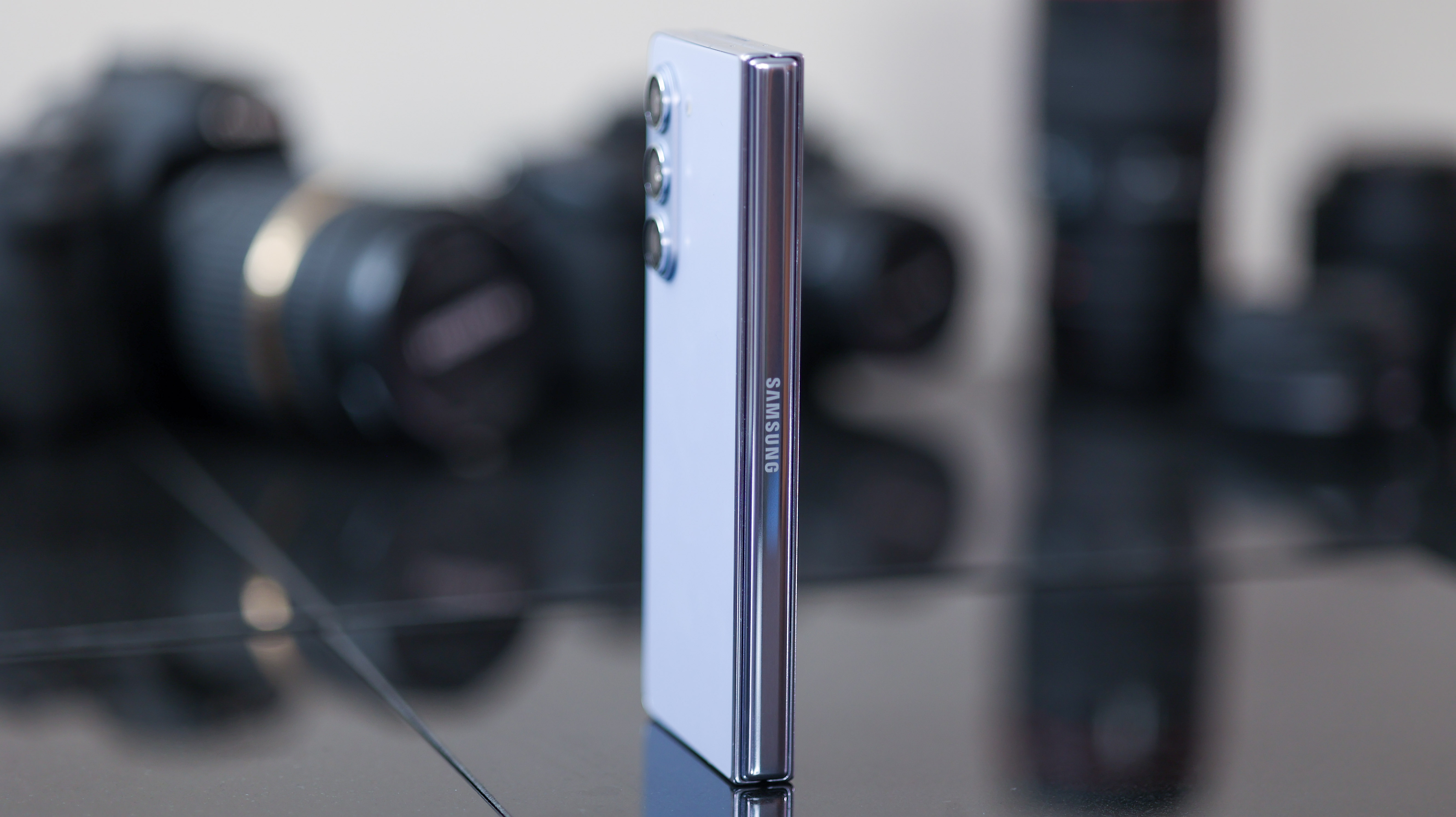
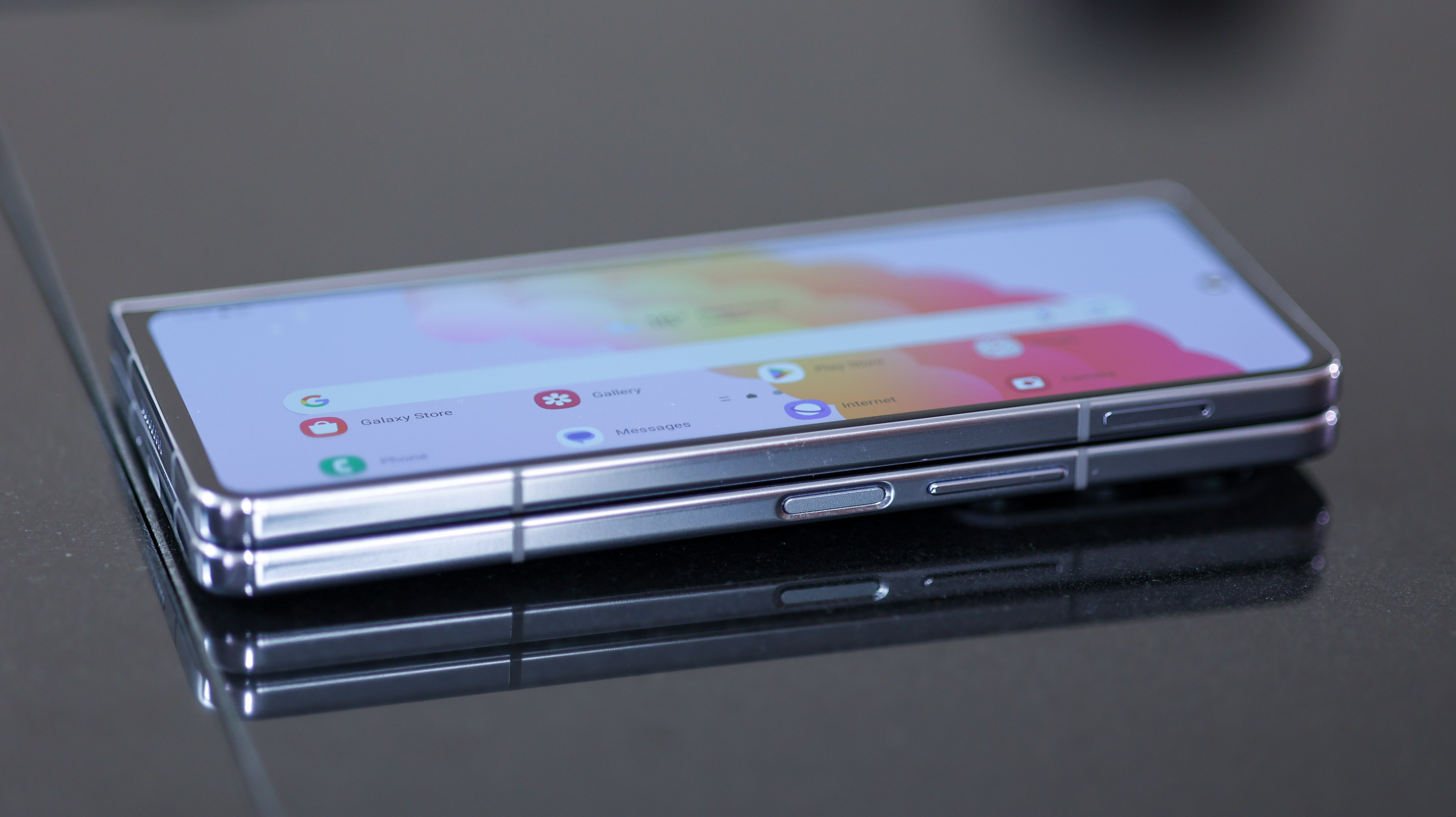
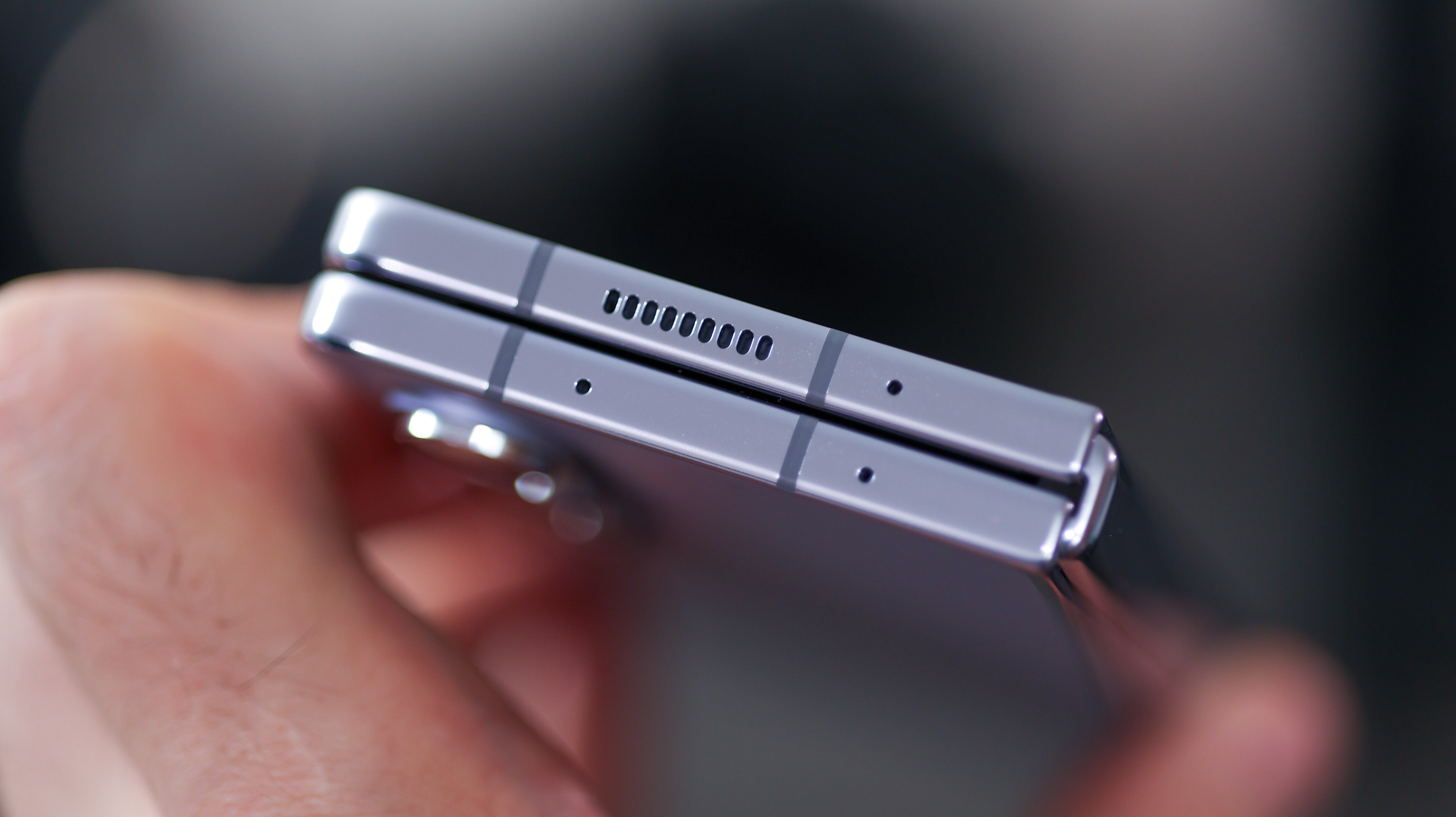
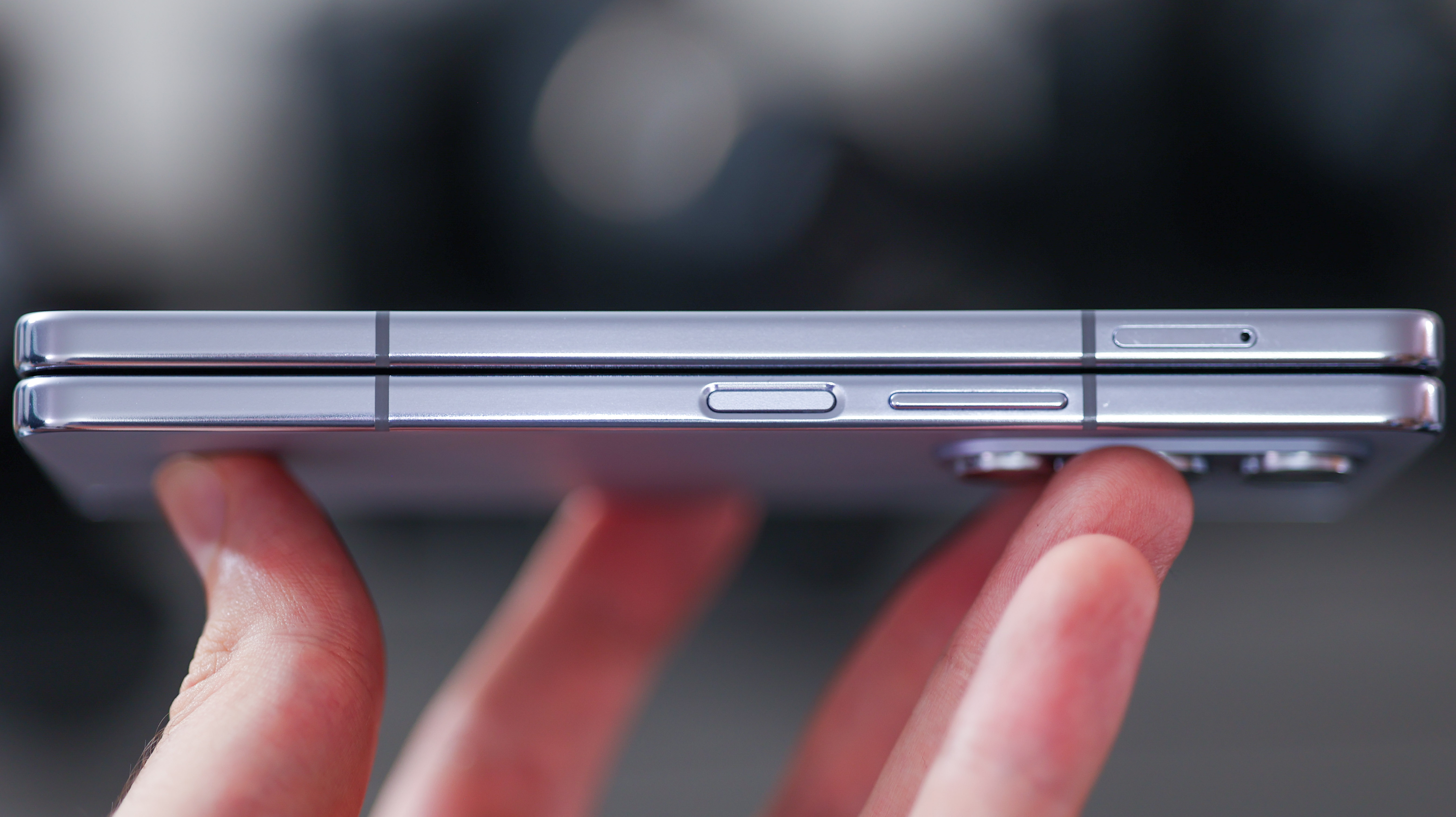
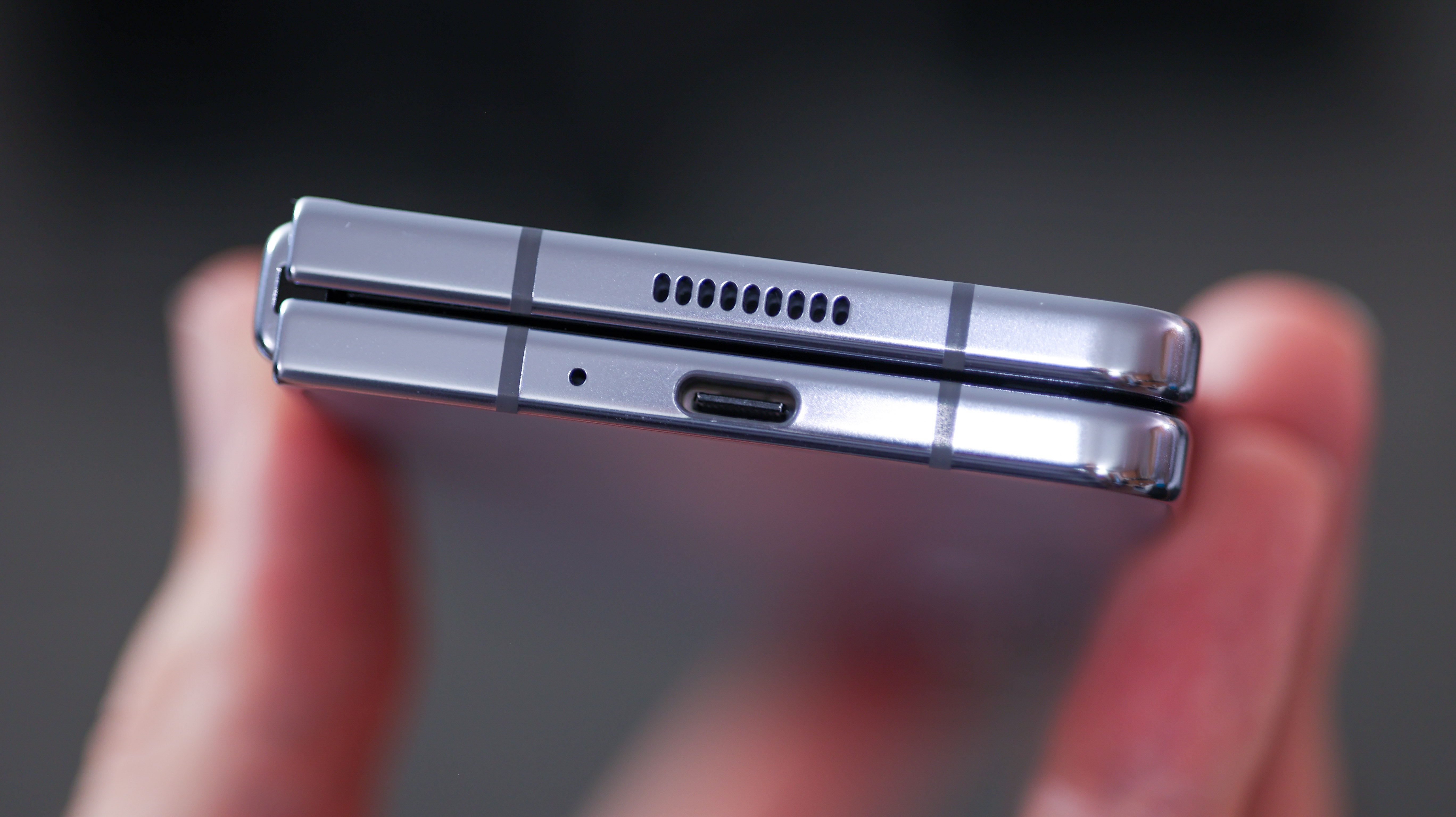
On the subject of durability, in addition to IPX8 water resistance, Samsung's hinge feels very solid. While other foldables may have smoother, easier-to-open and close hinges, Samsung's is one of the more robust, so it holds its form securely mid-fold and doesn't spring open or closed at any point when folding or unfolding.
Based purely on subjective – this feels tough enough to handle daily life – experiences, after two weeks of using it, the Z Fold 5 has left us feeling relatively confident in its durability, and while it's a bit slab-like, its styling is cohesive and a modest step forward compared to the Z Fold 4.
Samsung Galaxy Z Fold 5 Review: Screens
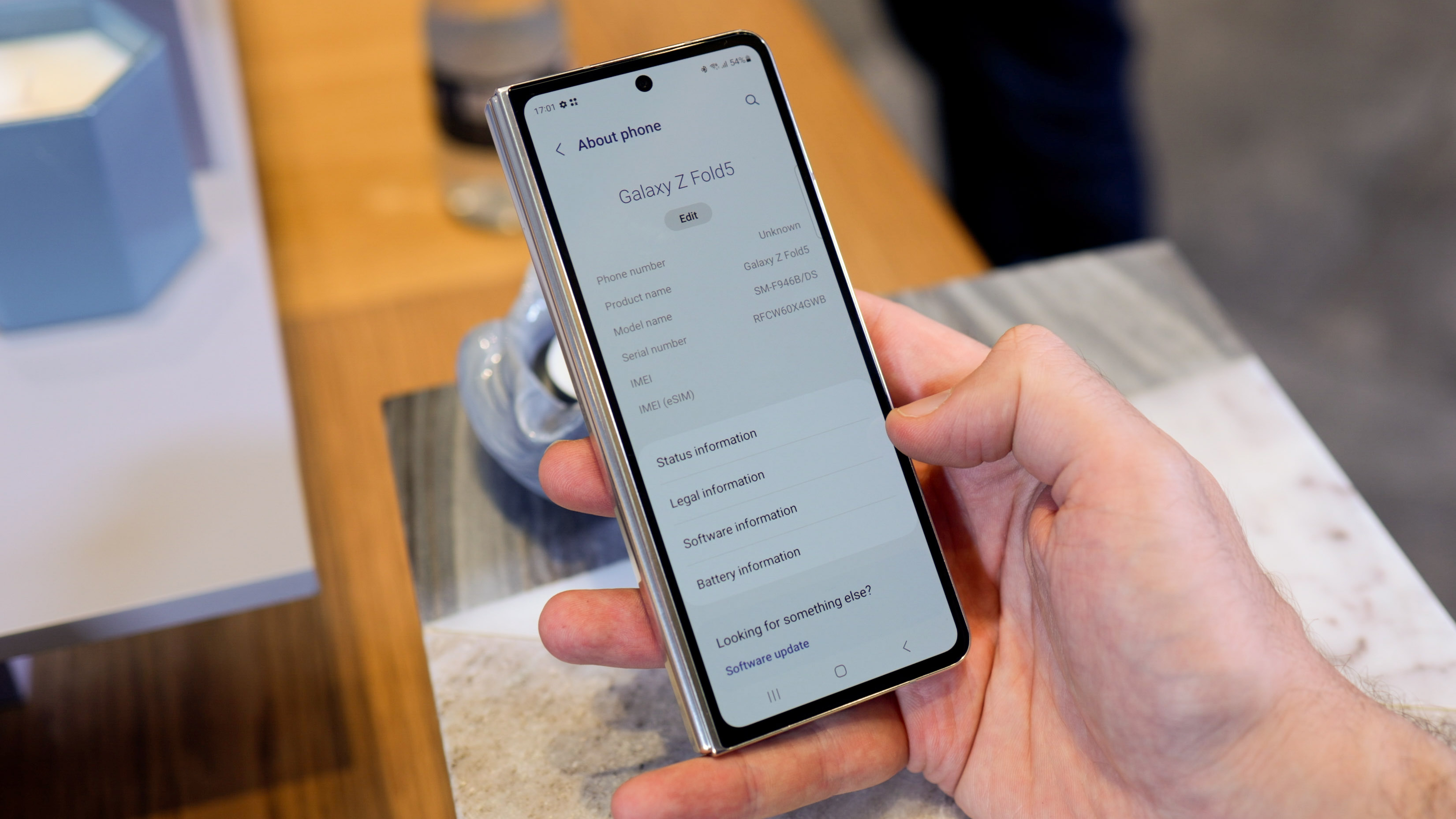
Both of the Galaxy Z Fold 5's screens are Samsung AMOLED 2X displays, which means they showcase vibrant colors and deep, inky blacks. They're also smooth, with 120Hz refresh rates, and are adaptive, so this smoothness can dial up or down between 1-120Hz to save power.
The 6.2-inch cover screen on the front of the Z Fold 5 is significantly taller than that of the Pixel Fold and narrower too. If you like a lot of space to type, it's a cramped experience that will take some getting used to.
In our first week with the Z Fold 5, we were often forced to unfold it for long bouts of messaging after making too many typos on the cover screen. Into our second week, we leveled up our claw-handed clasp to hit new heights of successful cramped typing, but it still wasn't as comfortable as using a wider phone keyboard.
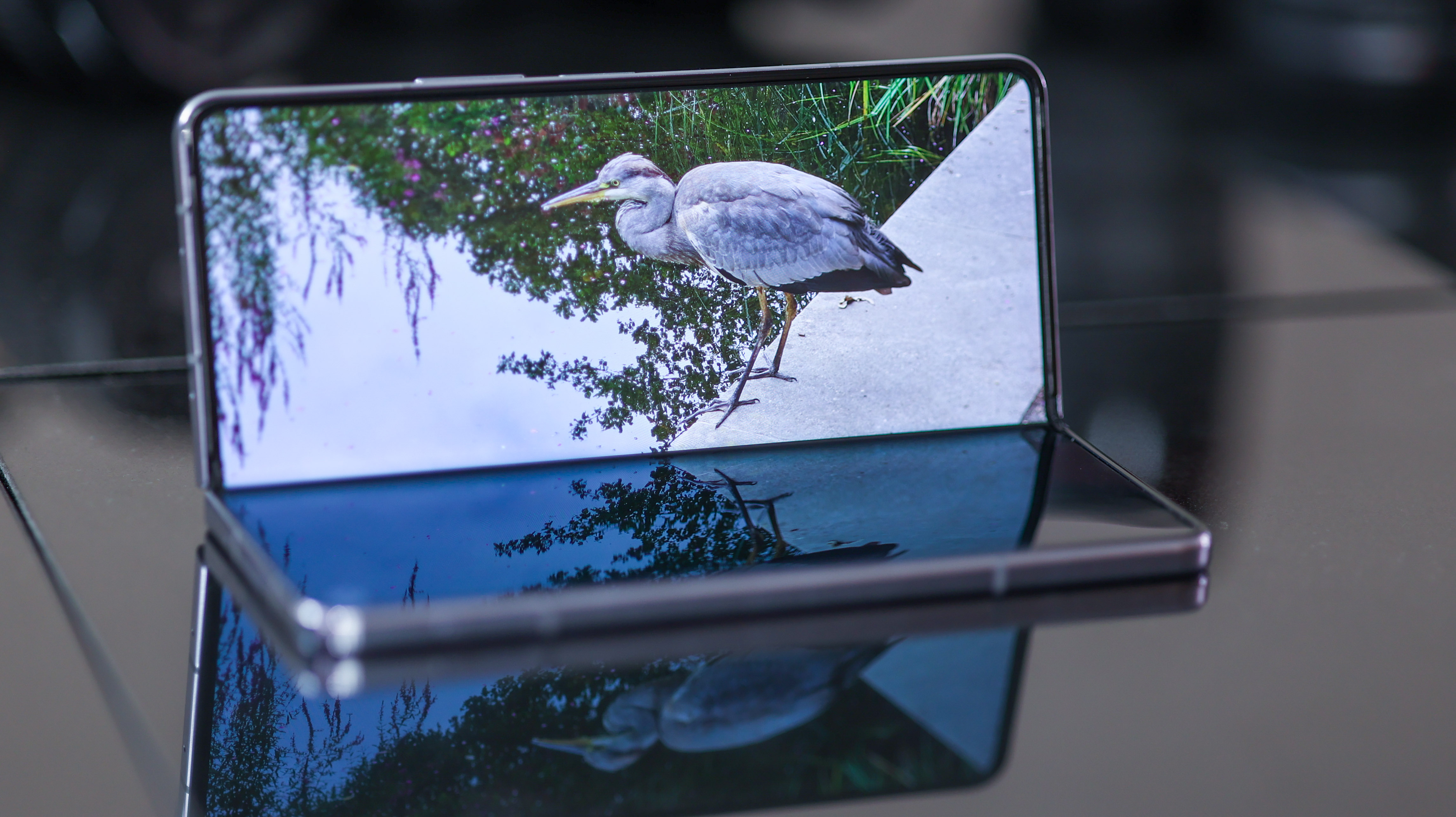
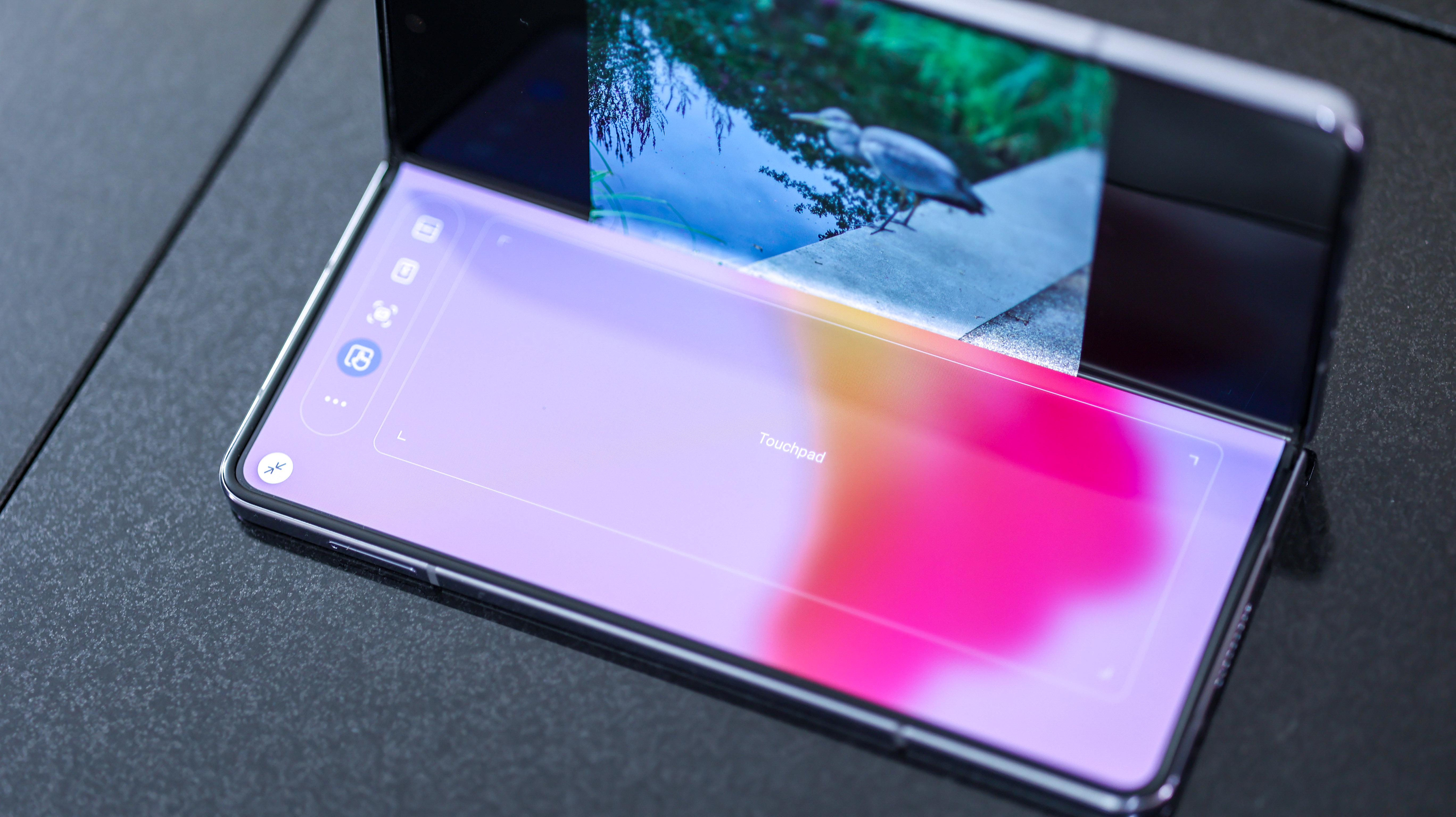
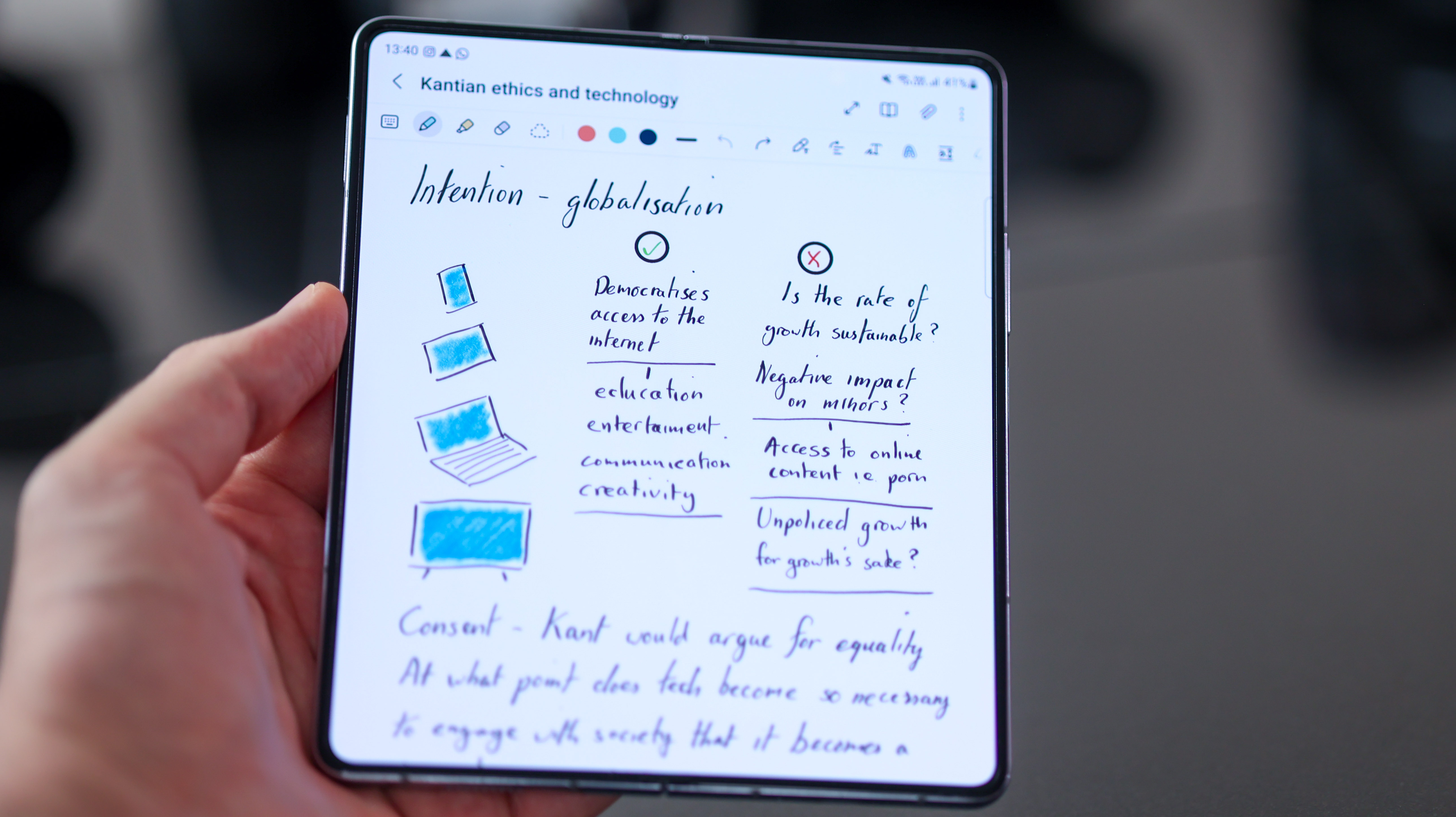
The main display is a 7.6-inch foldable panel with a resolution of 1812 x 2176, and it shares most of the same credentials as its cover-screen counterpart – 120Hz adaptive smoothness, Dynamic AMOLED 2X technology, and HDR support.
With a peak screen brightness of 1200 nits in high brightness mode, it should be easy to see what's on-screen in all but the sunniest environments. Samsung's also ramped up the peak spot brightness, so when playing HDR content, the phone can crank out through-the-roof contrast ratios and beam highlights as brightly as 1750 nits.
To look at, if you can get past a visible crease line running down the middle of the Z Fold 5, it's big screen is a beauty. The interface looks excellent on it, colors pop with vibrancy (but not too much), and it's responsive to the touch.
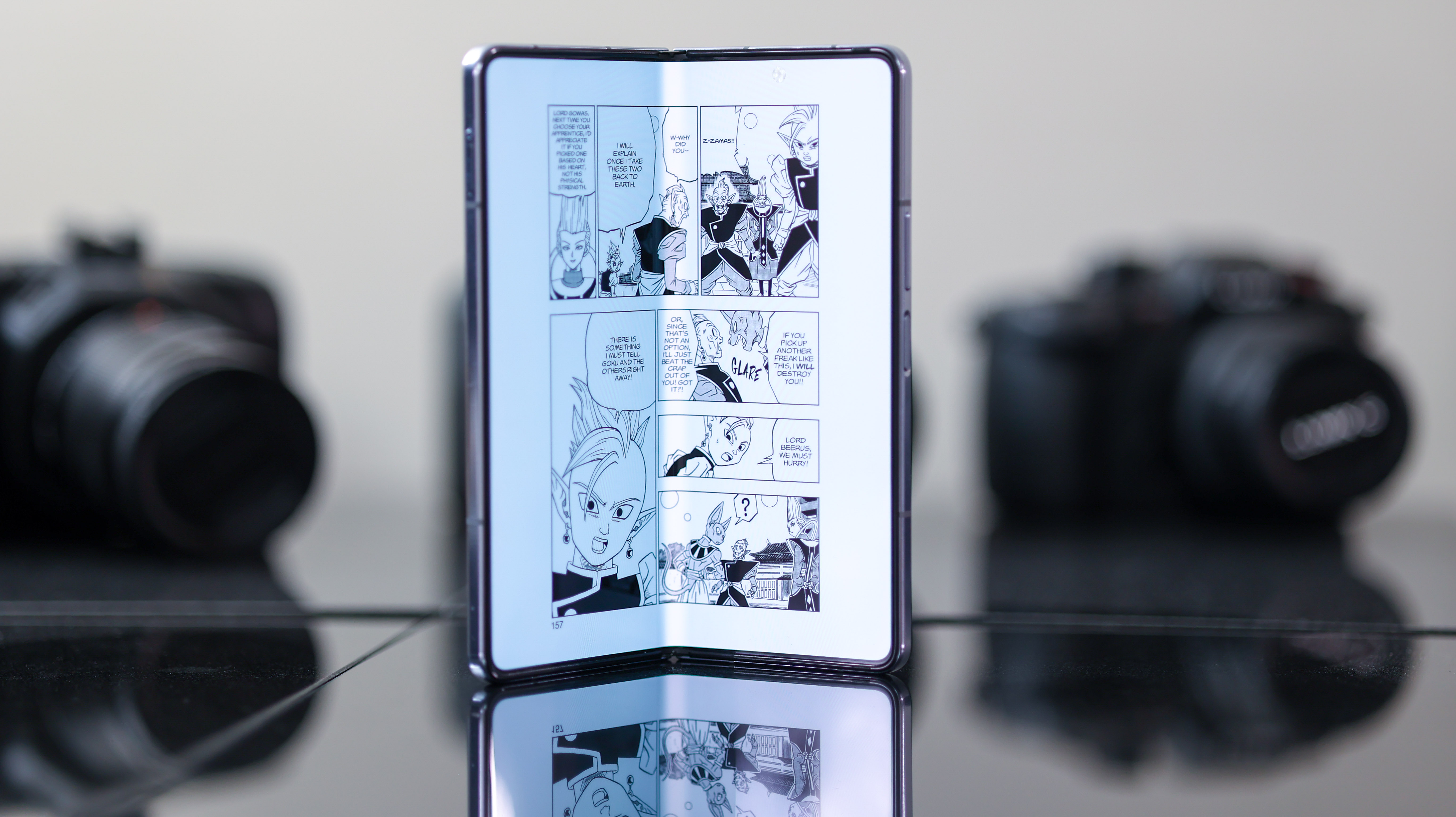
If you're thinking of a foldable as a Kindle replacement, while the Z Fold 5 is more reflective than an E Ink screen, its size is very good for reading on, and its low minimum brightness makes it a winner for bedtime reading.
Watching videos on the Fold 5 is hit-and-miss. If you're in a bright environment, having the crease running down the middle of the screen can catch the light, creating a distracting glare.
Part-fold the phone, though, which pushes the picture to the top half, rest it on a surface for a more cropped but less compromised view, and it fares much better. In the dark, the crease is much less noticeable and full-screen videos look great.
Only the main display supports S Pen input at up to 4,096 levels of pressure sensitivity, though the S Pen doesn't ship with the phone, and you can't use just any S Pen. To write on your Z Fold 5, you'll need to either pick up the new S Pen cover, buy an S Pen Pro, or buy the new Creator's edition S Pen.
Samsung Galaxy Z Fold 5: Camera specs
The Z Fold 5 has very similar camera hardware to the Z Fold 4, with the primary 50MP sensor measuring 1/1.56 inches. Matched with an f/1.8 lens, a 23mm wide-angle, and phase detection autofocus (PDAF), this is all competitive with other foldables on paper.
While there's no periscope zoom camera, unlike the Huawei Mate X3, the telephoto camera is a 10MP sensor that clocks in at 1/3.94 inches, producing a 1-micron pixel size. As for the optics, there's an f/2.4 lens with a 66mm focal length, PDAF, and OIS.
Onto the ultra-wide, it's a 12MP sensor with 1.12-micron pixels, an f/2.2 aperture, and a 123˚ field of view, equating to a 12mm focal length.
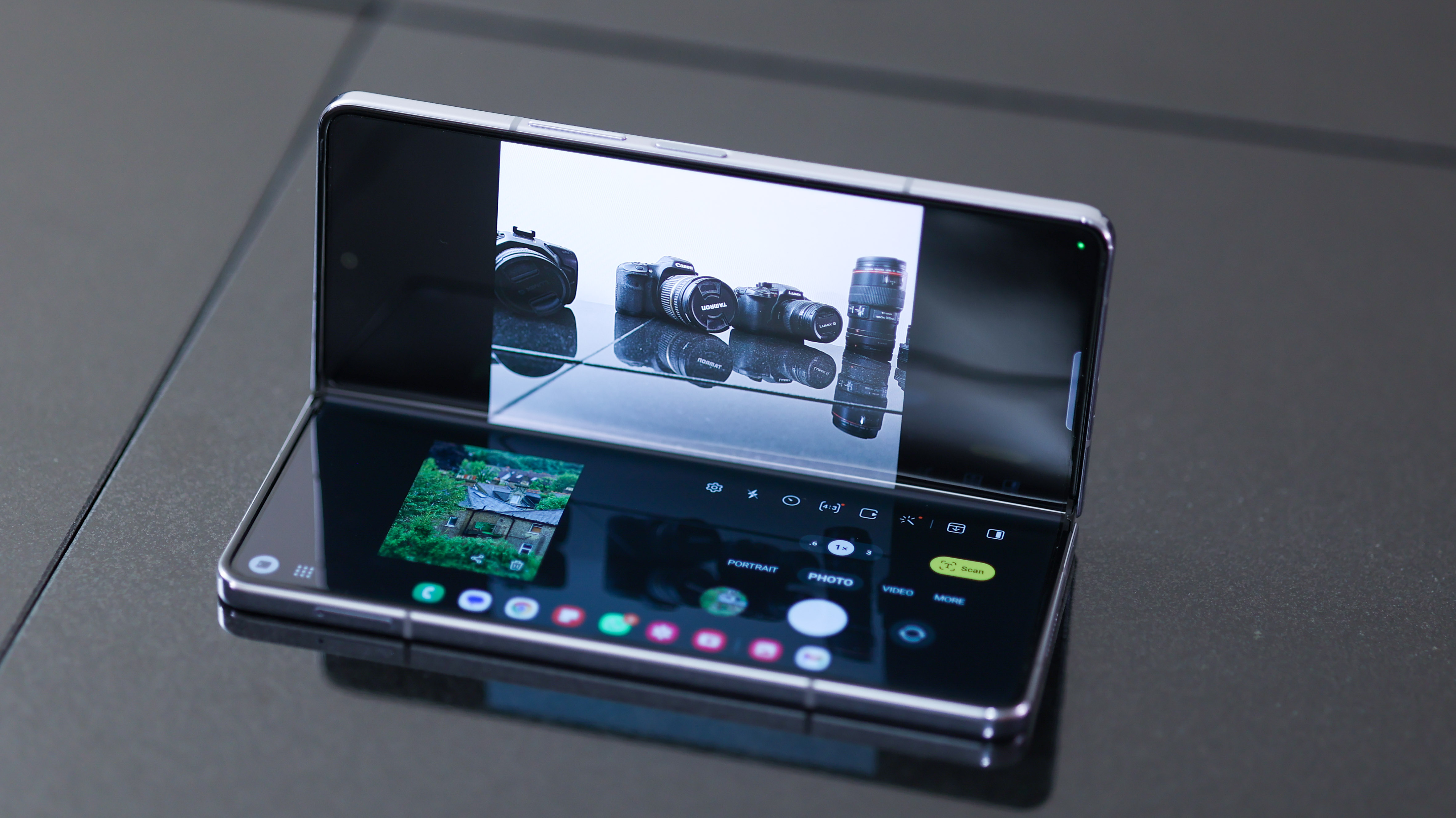
The camera takes advantage of the phone's Flex Mode, so when the Fold 5 is half-folded, the top half of the screen acts as a viewfinder, while the bottom half serves up your shooting controls. This is especially handy in Director's View, which previews all three focal lengths on the secondary display, so you can make an informed decision when you switch out. Pro Mode also really benefits from a split-screen view, with the top half of the foldable clear for your picture and the bottom half displaying manual shooting options.
The Z Fold 5 captures videos at up to 8K resolution at 24fps, and 4K at up to 60fps, and if you're shooting in Pro Mode, manual ISO can be set as high as 3200, and the shutter speed up to 30 seconds.
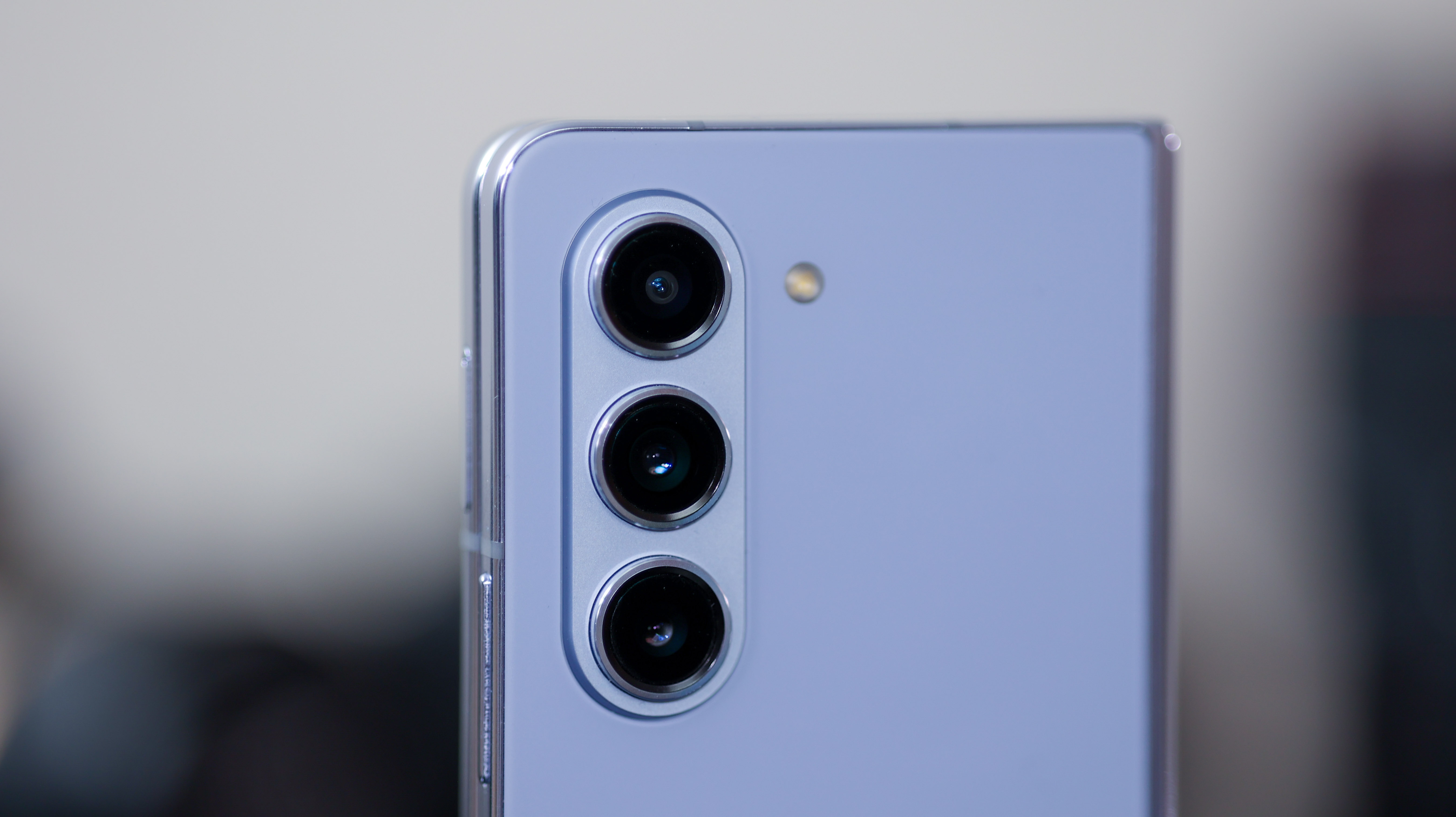
There's also an under-display selfie camera in the main screen which is 4MP with an f/1.8 aperture, and in the cover screen is a 10MP, f/2.2 selfie camera.
The Z Fold 5 packs Samsung's impressive array of camera modes, including Pro Mode and Camera RAW, a perfect pairing for big-screened edits using Adobe Lightroom for Mobile, with Samsung Boost giving Fold 5 owners a two-month membership.
Samsung Galaxy Z Fold 5 Review: Camera
Despite not being the best camera phone of 2023, the Galaxy Z Fold 5 covers most bases competitively when compared to other foldables.
Starting with the primary 50MP camera, and the Fold's a great point-and-shoot when lighting is plentiful, capturing ample detail and a relatively balanced picture. Many will like the warm, vibrant shots it takes, though over-sharpening and boosted vibrancy might not be to everyone's tastes.
Photos look crisp out of the camera, ready for Instagram or WhatsApp, but miss out on the broad dynamic range you get from phones like the Xiaomi 13 Pro, which lean a bit more heavily on computational photography, pulling more detail out of highlights and shadows.
You can see an example of the Z Fold 5's three optical focal lengths below:
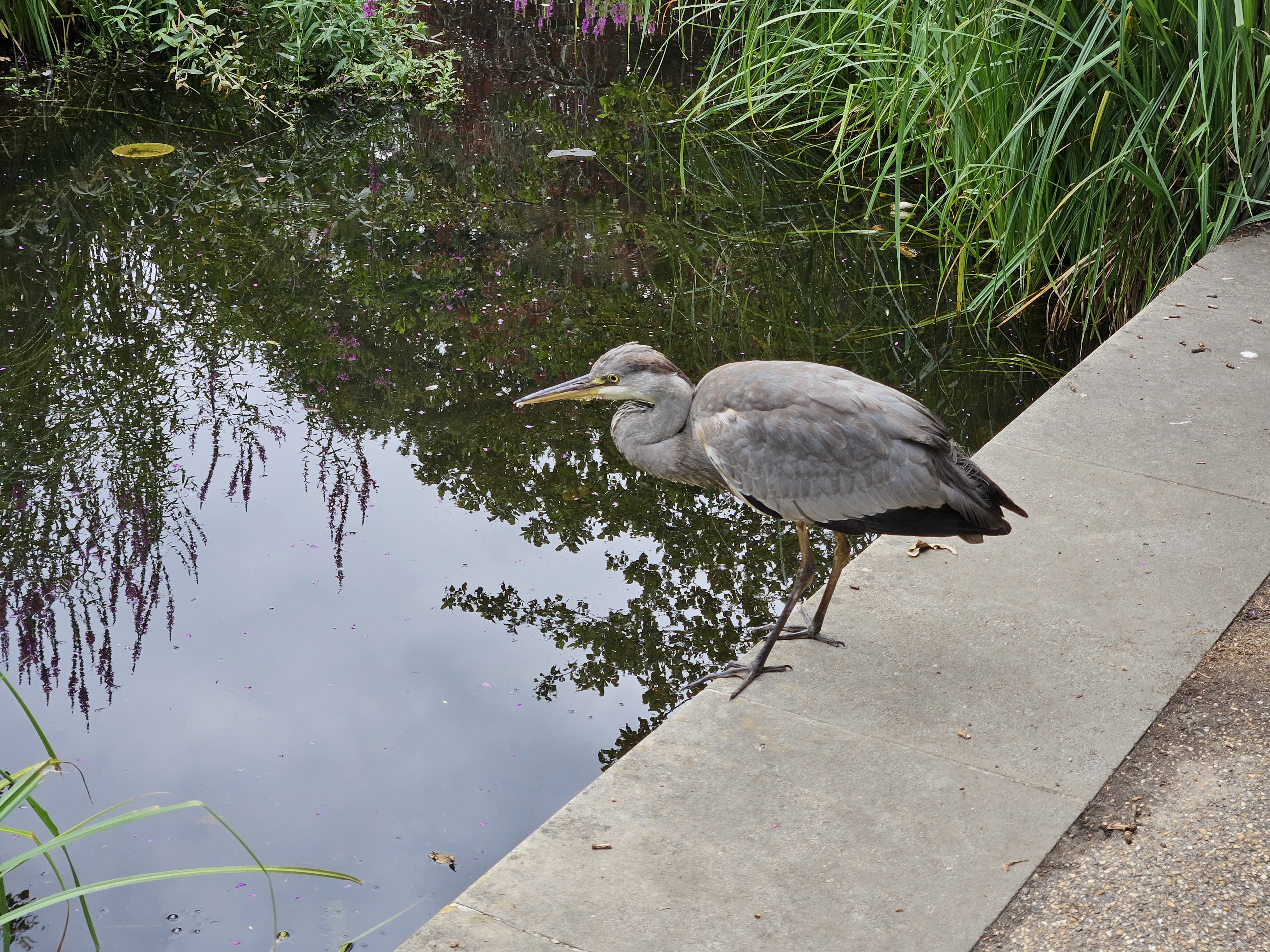


The primary camera is quick to focus and take a photo, and can capture a relatively shallow depth of field when close to a subject.
Samsung's contrast-rich photos won't give you as much wiggle room as some other phones to edit. Thankfully, the phone's Pro Mode and RAW capture really help here. In Pro Mode you can dial down some attributes, and in RAW, naturally, you can pare processing right back.
Expert RAW, available through the Galaxy Apps store, is a turbo-charged RAW camera and a great option for enthusiasts. This captures higher dynamic range RAW photos, achieved through bracketing and other computational photography, making it a handy middle ground between RAW and auto modes.
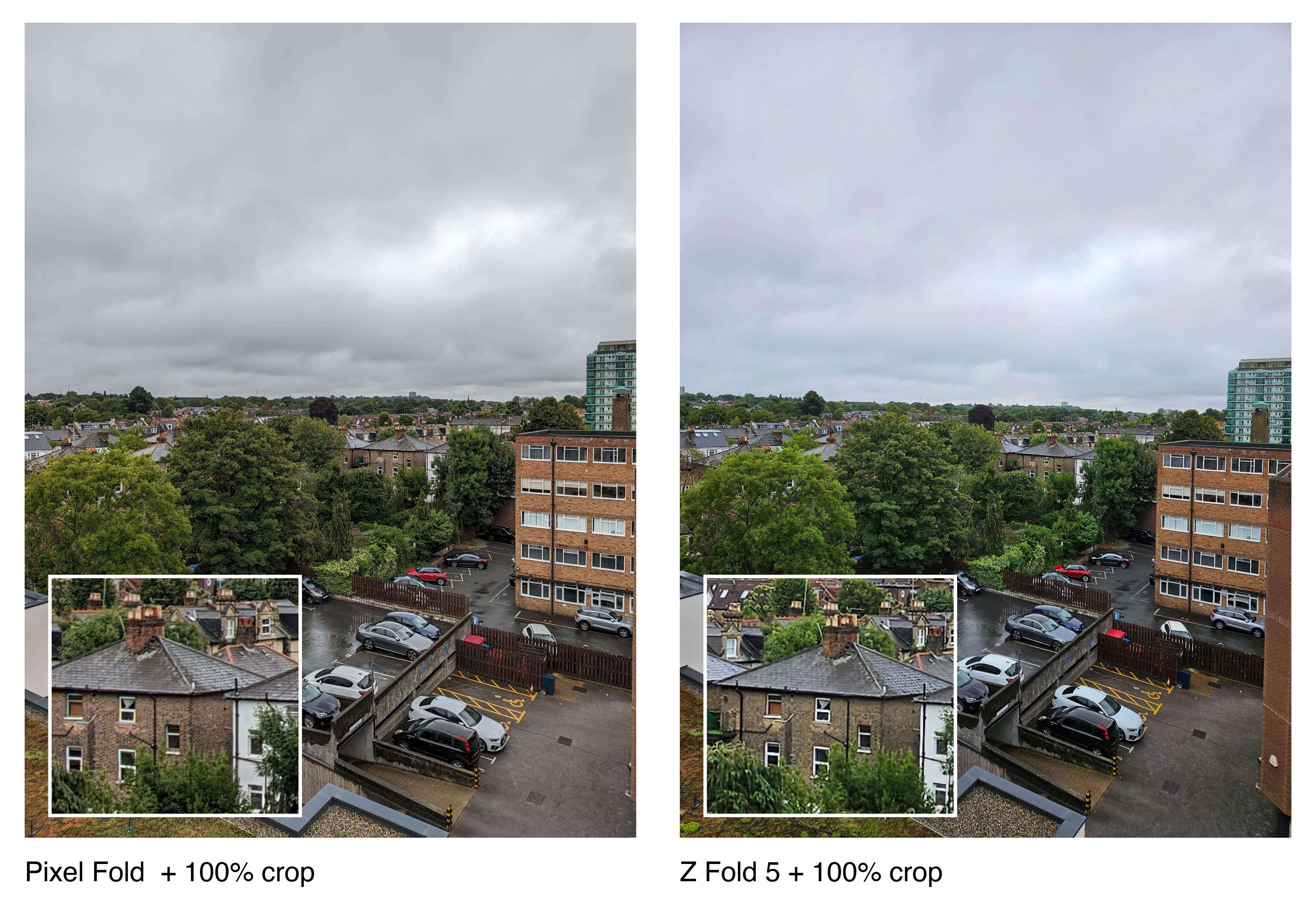
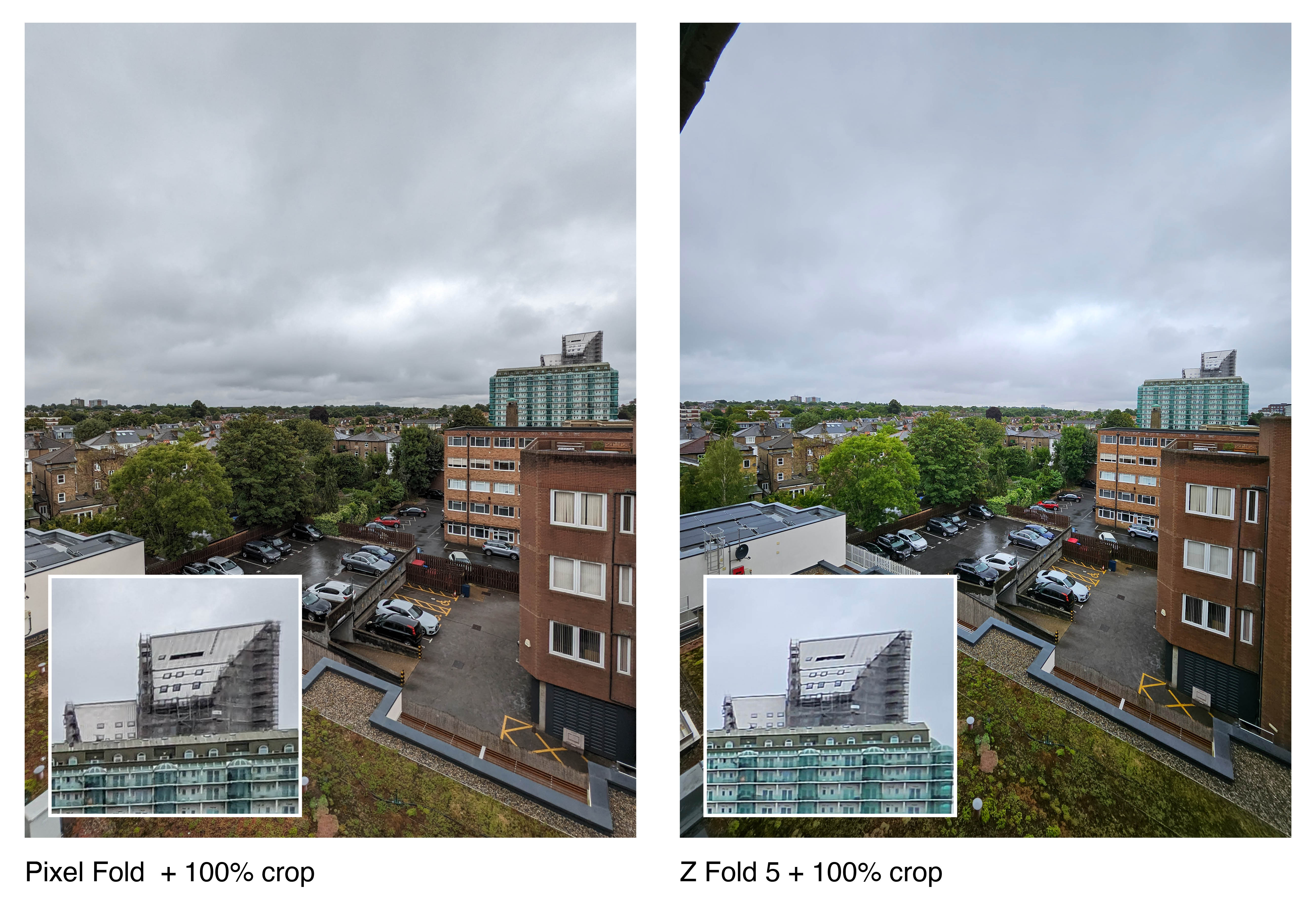
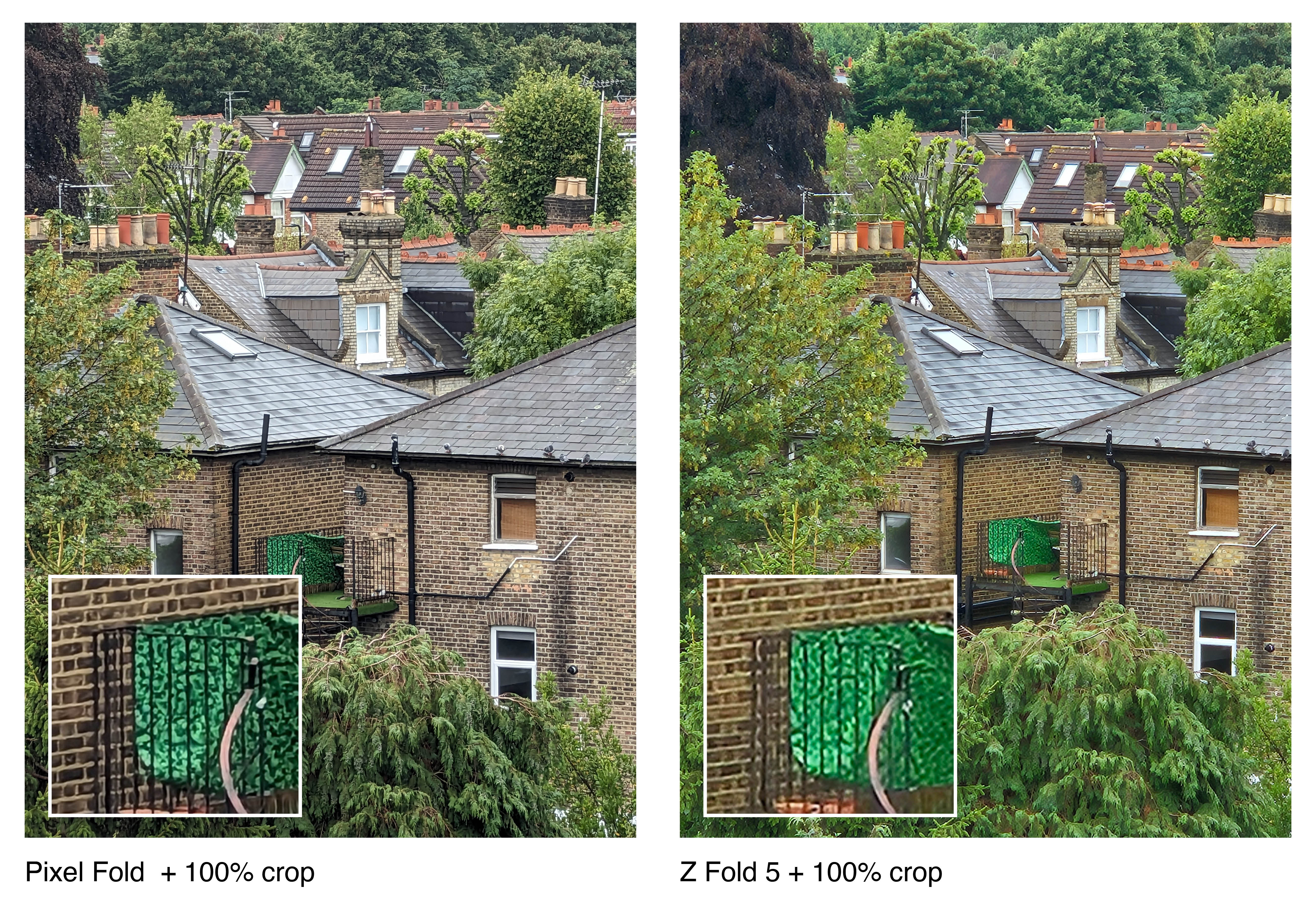
Zoom is where the Pixel Fold edges ahead of the Z Fold 5 with its five-times optical reach. On the other end of the spectrum, the Z Fold 5 has a wider field of view across all three of its cameras, so if you lean towards pulled-back shots, it might be more up your street.
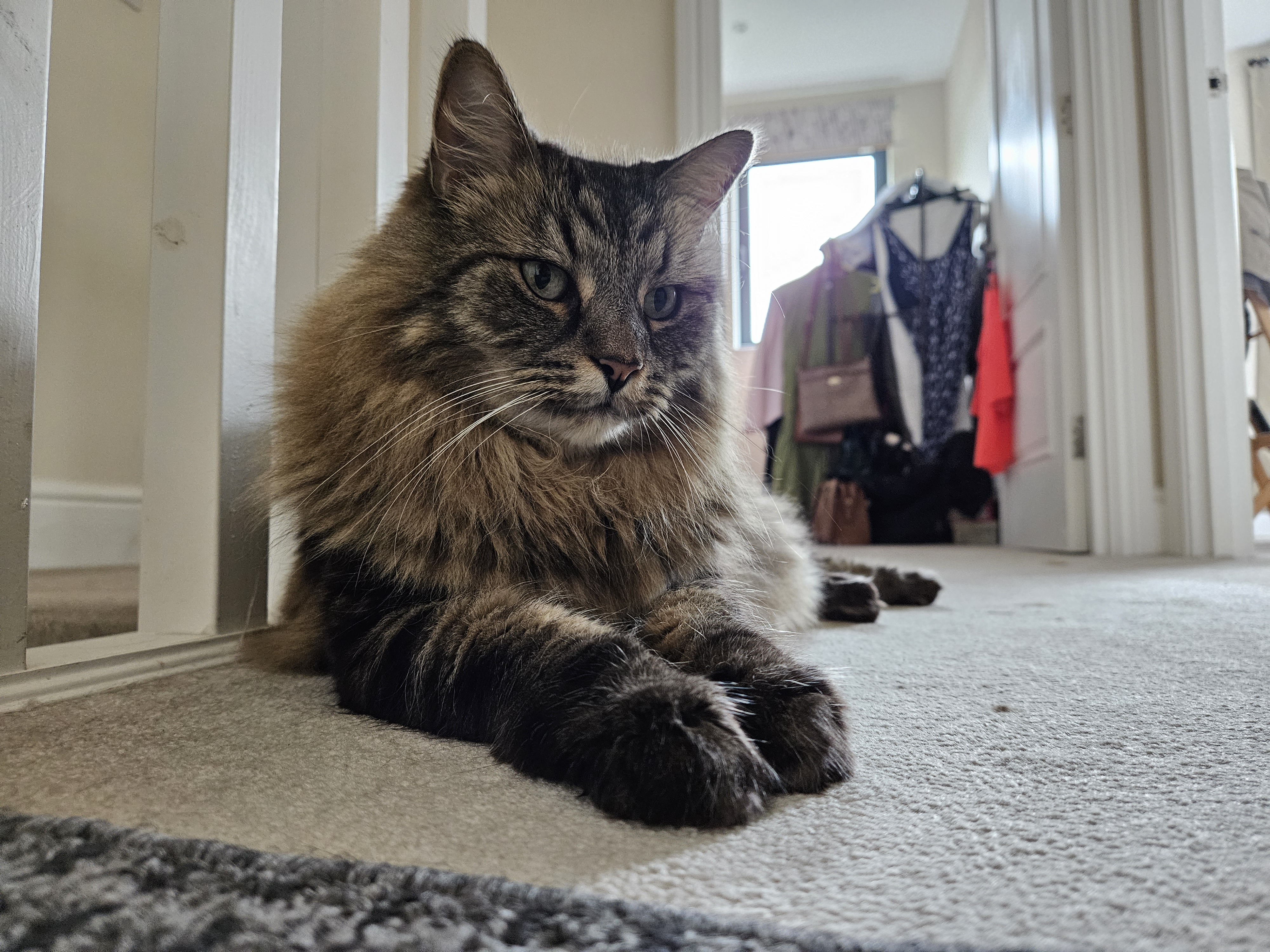
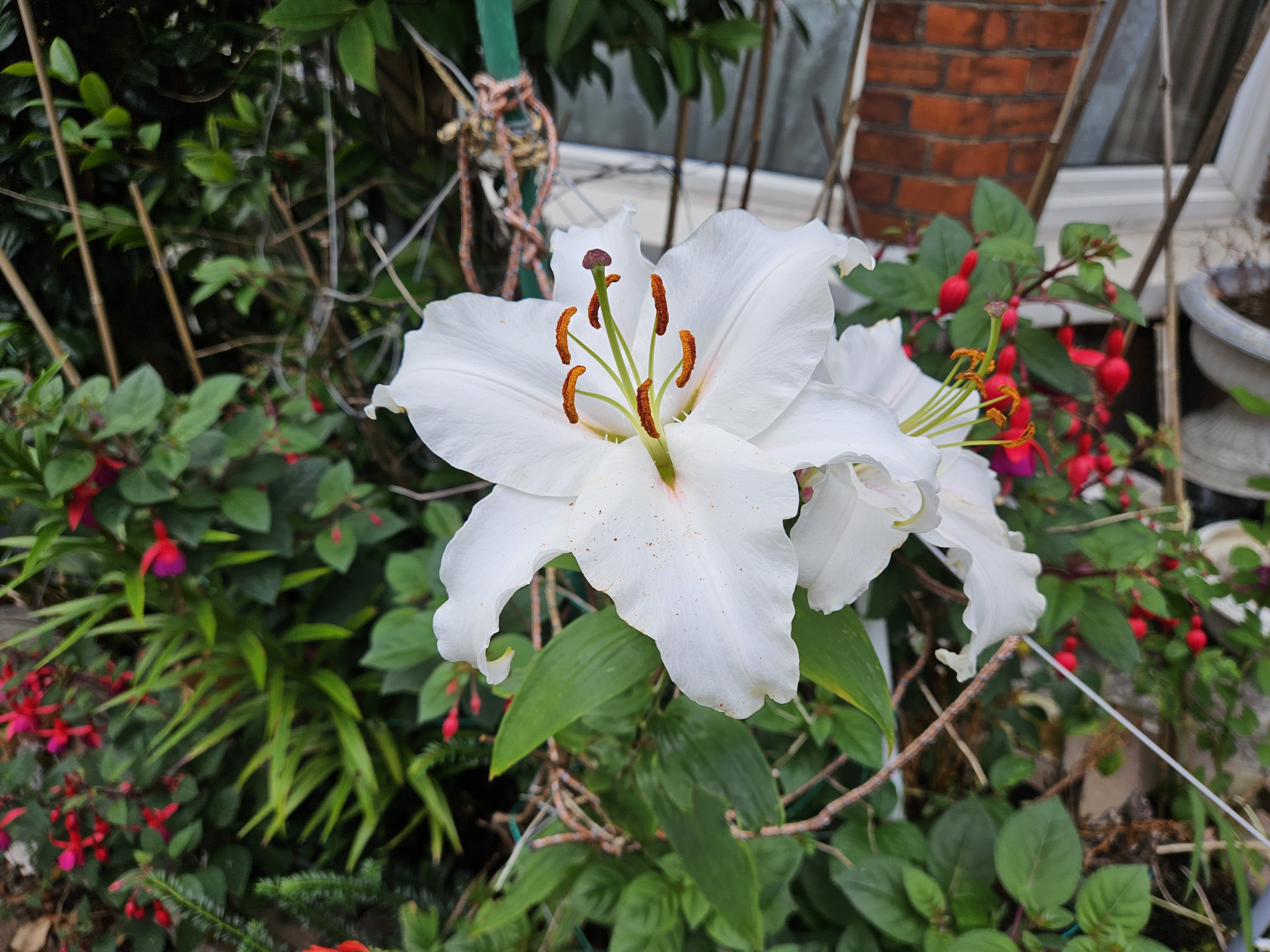

Selfie fans should try and use the main camera around the back of the phone, opening the Z Fold 5 up. The second choice should be the 10MP selfie camera in the cover screen, and the worst performer is the under-display camera beneath the foldable screen. Even in bright environments, it captures flat selfies that leave you looking a bit dead behind the eyes. To be fair to Samsung, it positions it as a video-calling camera, and we'd agree.

The phone's main camera is the only one you'll want to lean on for night shots. While all the cameras boost exposure when the lights drop and add a mauve tint to shots, the ultra-wide and telephoto cameras miss out on detail.
In mixed lighting, the main camera is also the best snapper when it comes to shadow detail, though as illustrated below, color consistency across cameras is impressive across all three.

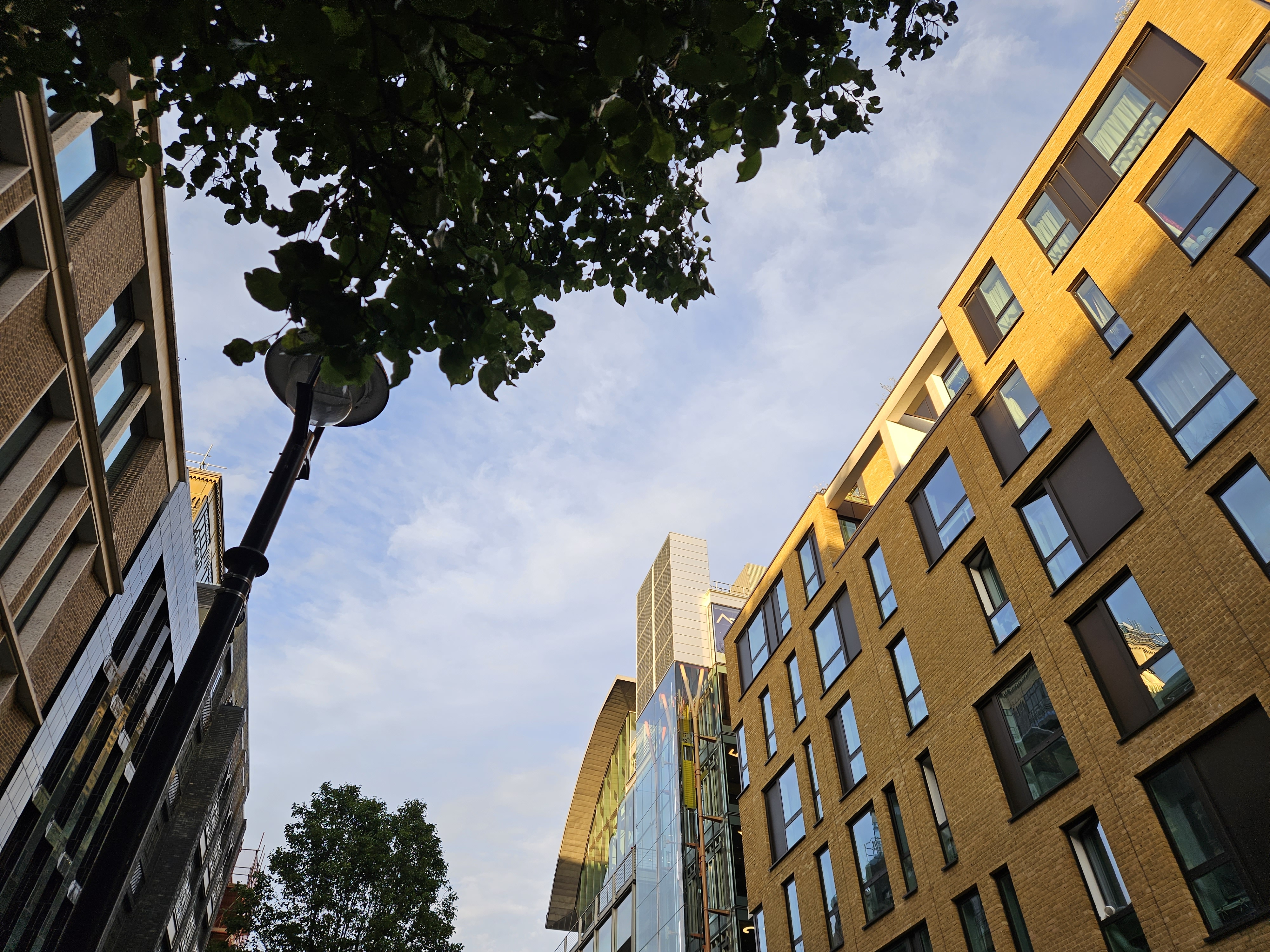
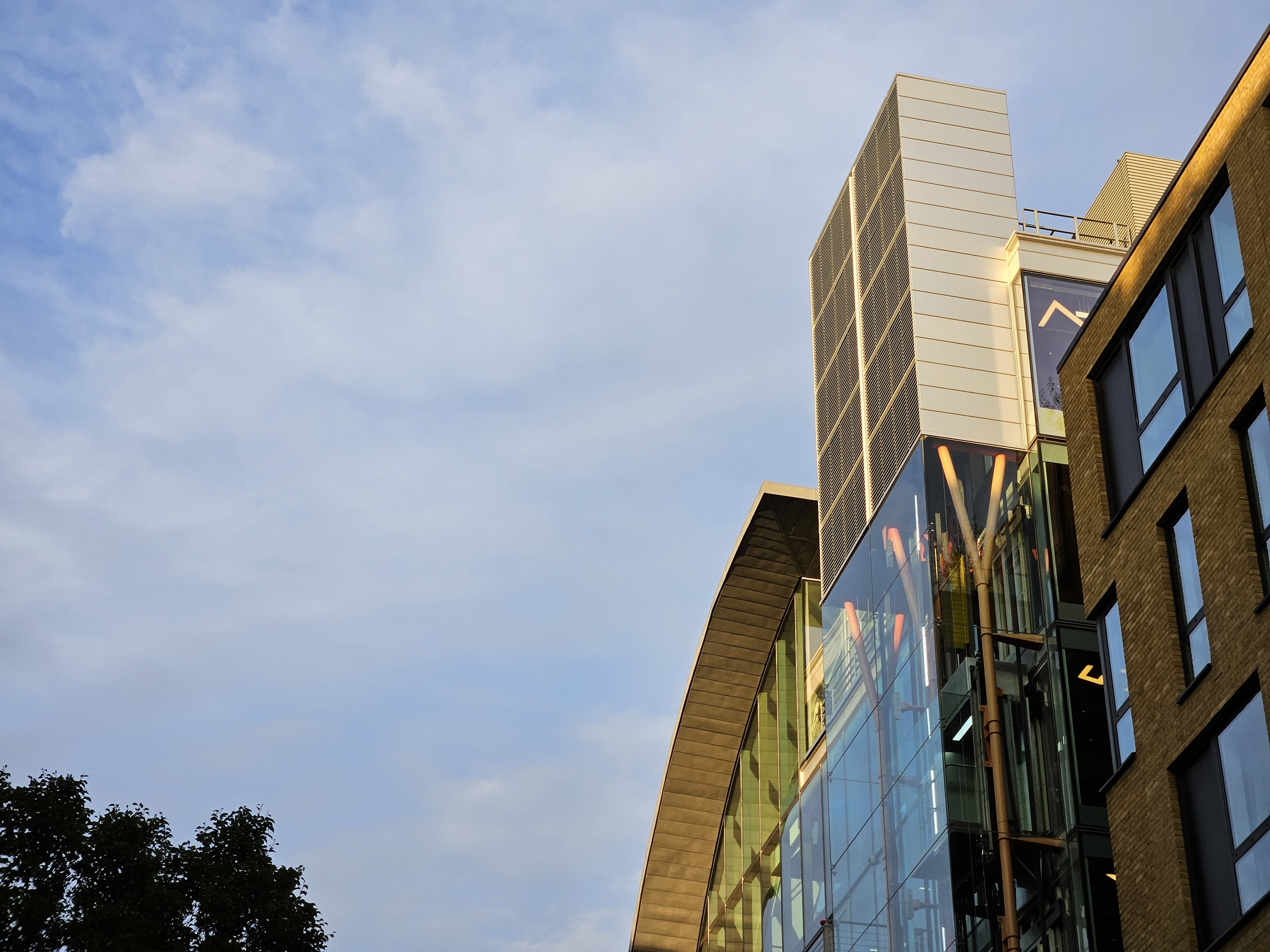

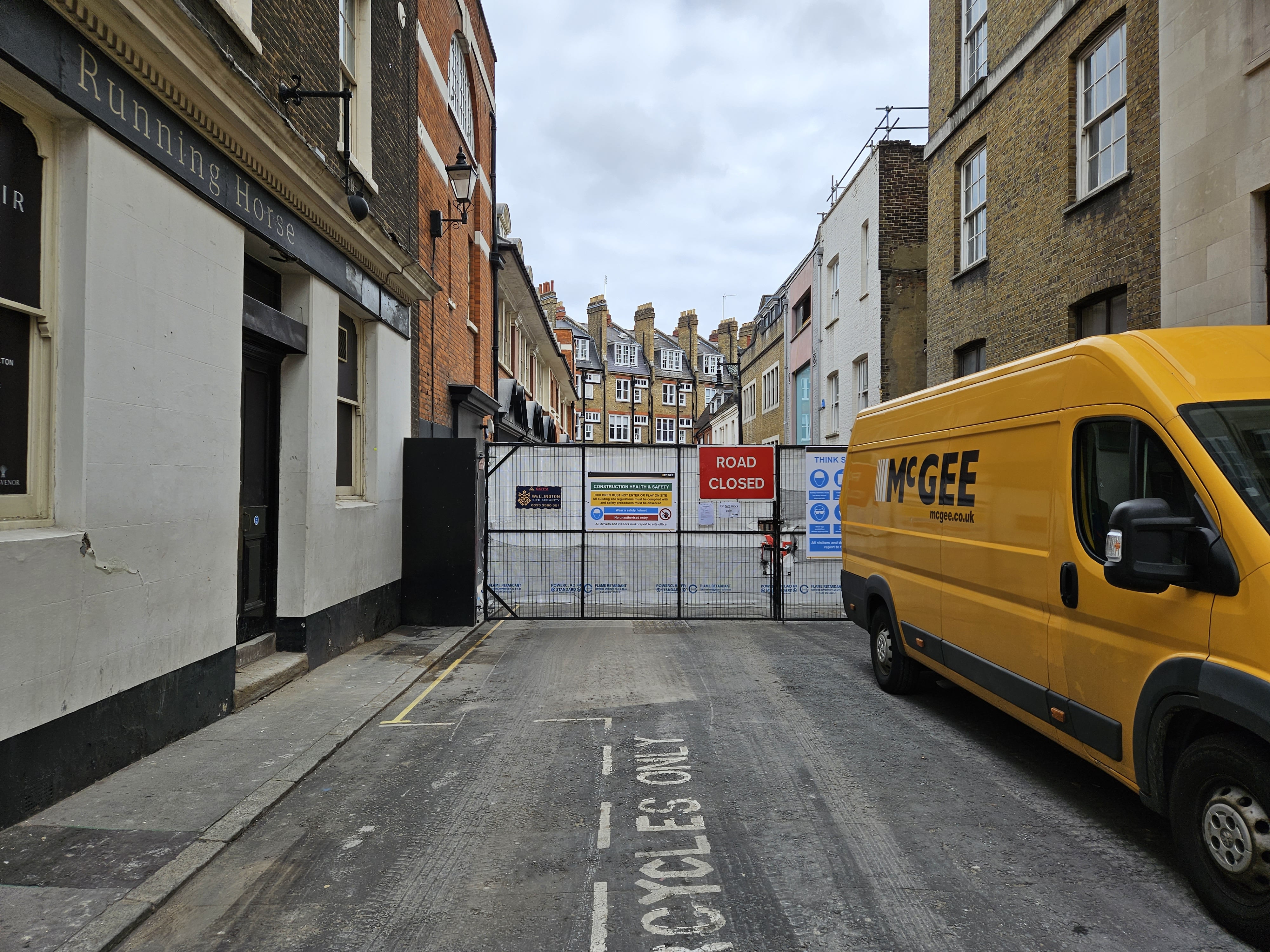

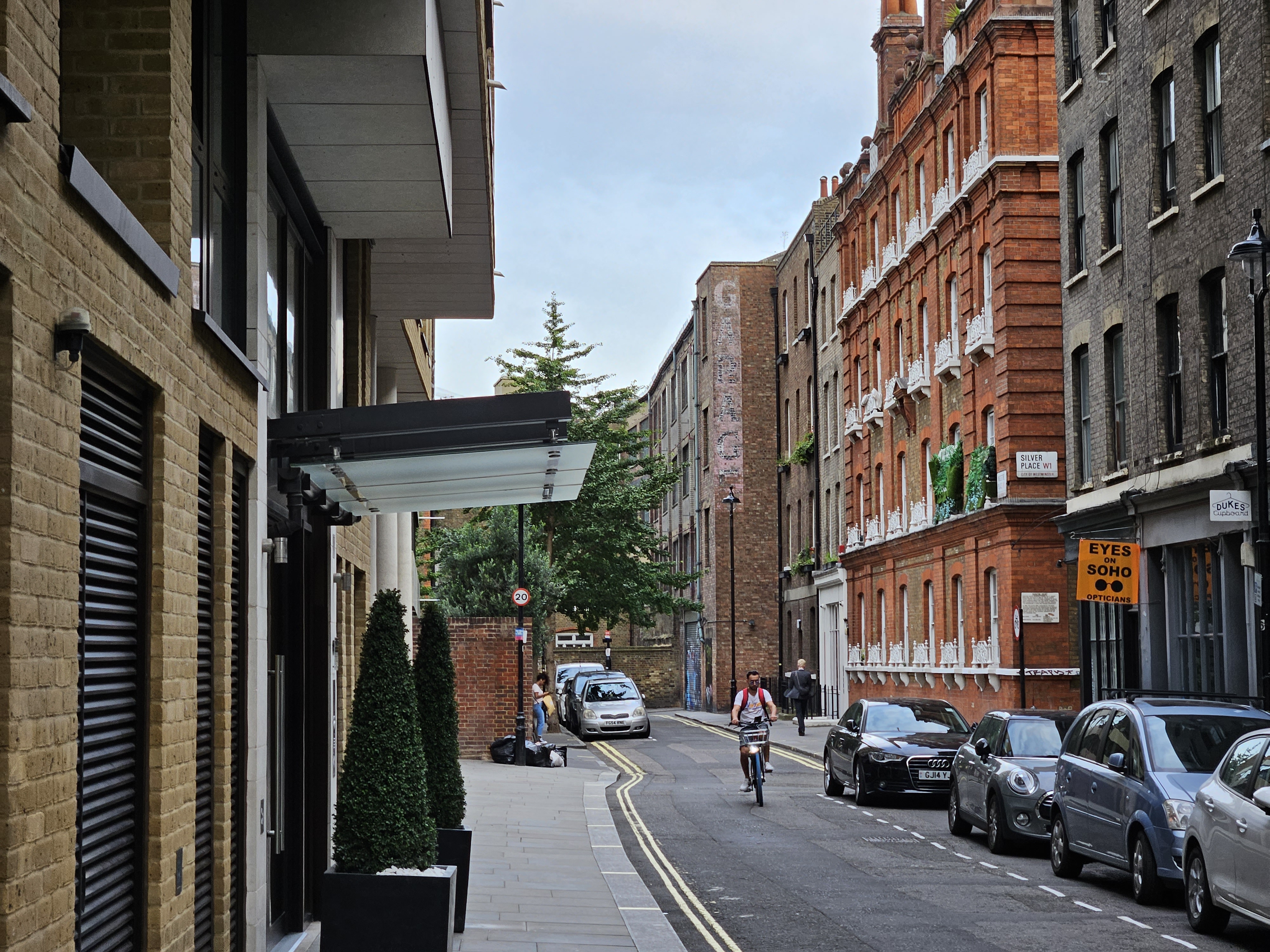
Samsung Galaxy Z Fold 5 Review: Additional features
The Galaxy Z Fold 5 may have a modest-sized, 4400mAh battery, but it still lasts a comfortable day, even with moderate use and a roughly 65/35 split between the cover screen and main display, respectively.
With Snapdragon 8 Gen 2 for Galaxy internals, the Z Fold 5 is the most powerful foldable on the market, along with the new Xiaomi Mix Fold 3, and a new thermal cooling system is also in-place to keep heat at bay. We gamed on it for about 40 minutes, and while it got warm, it didn't get hot, which is great going for a foldable.
Samsung's a bit heavy-handed with its pre-loaded apps and features, with its OneIU interface on top of Android packing a tonne of functionality and a fair bit of bloat. Nevertheless, it's this functionality that gives it the edge over other foldables out now.
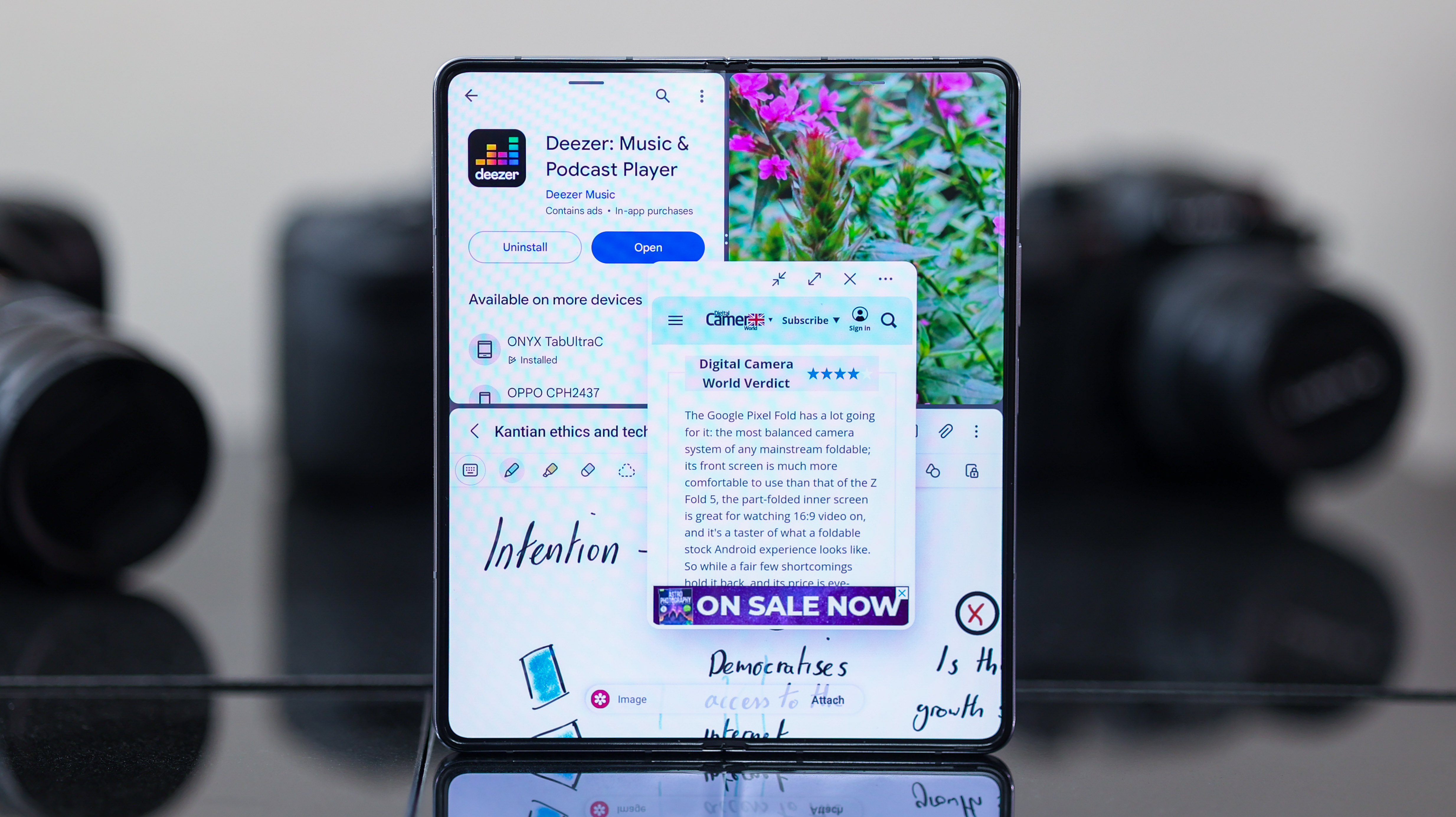
Open up the phone, and when you fire up any app, Samsung's handy taskbar appears at the bottom of the screen with up to 10 app shortcuts. You can also drag apps into a split screen mode from the taskbar or activate a floating window for up to eight running apps on-screen at once.
This multi-tasking madness is a show of strength for the phone, as it doesn't put any of these eight open apps to sleep, so you can quickly whizz between them and dock them in the margin for easy access when the screen gets too busy.
So while aspects of other foldables best Galaxy Z Fold 5, Samsung's software is the best around for power users.
In one scenario, we were running Canon camera software and Lightroom concurrently, with Adobe Express docked alongside WhatsApp and Instagram, working on getting posts lined up for a brand account – bypassing the Z Fold 5's camera in favor of our Canon EOS R6 but still capitalizing on its big screen and ample horsepower.
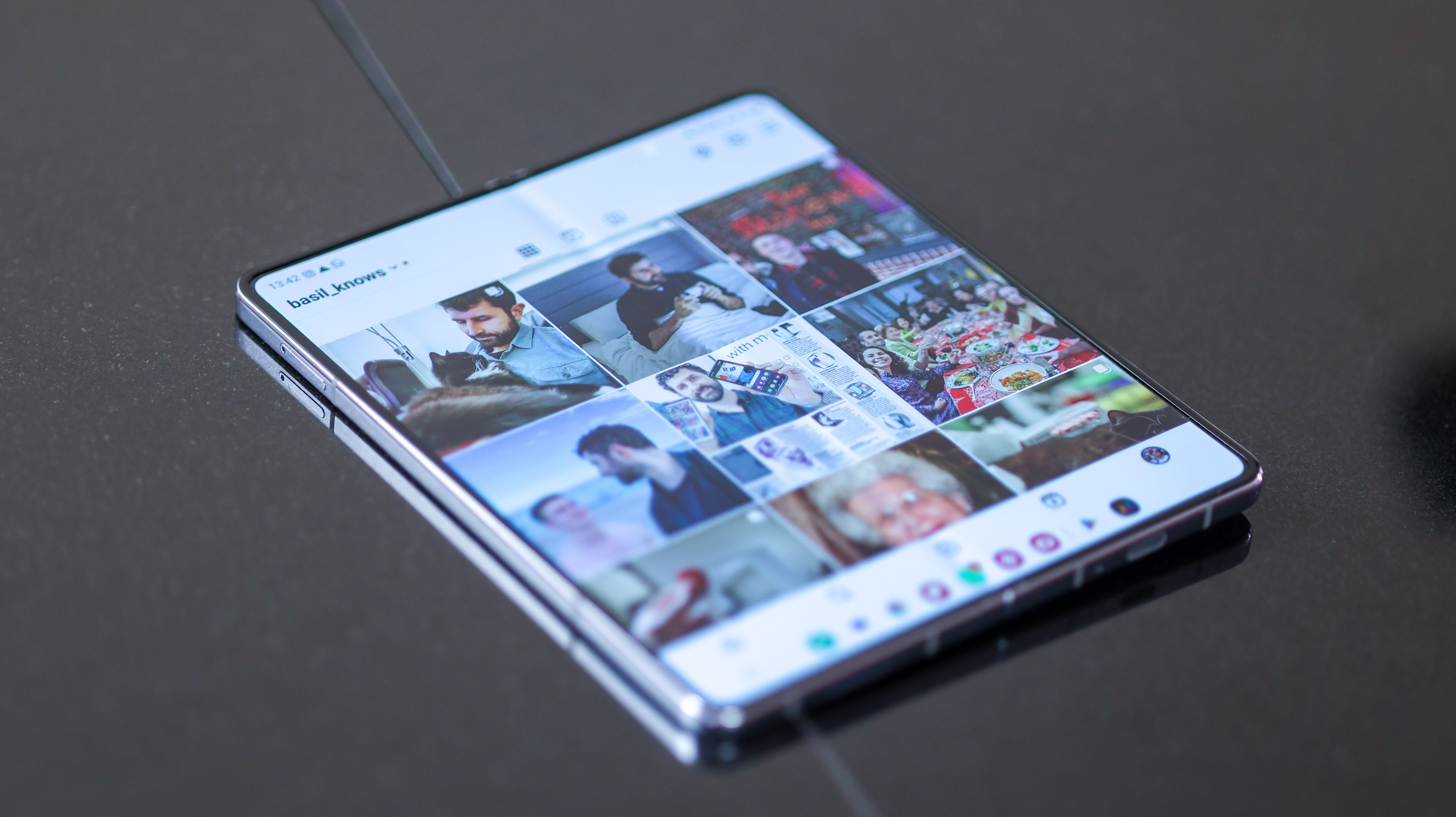


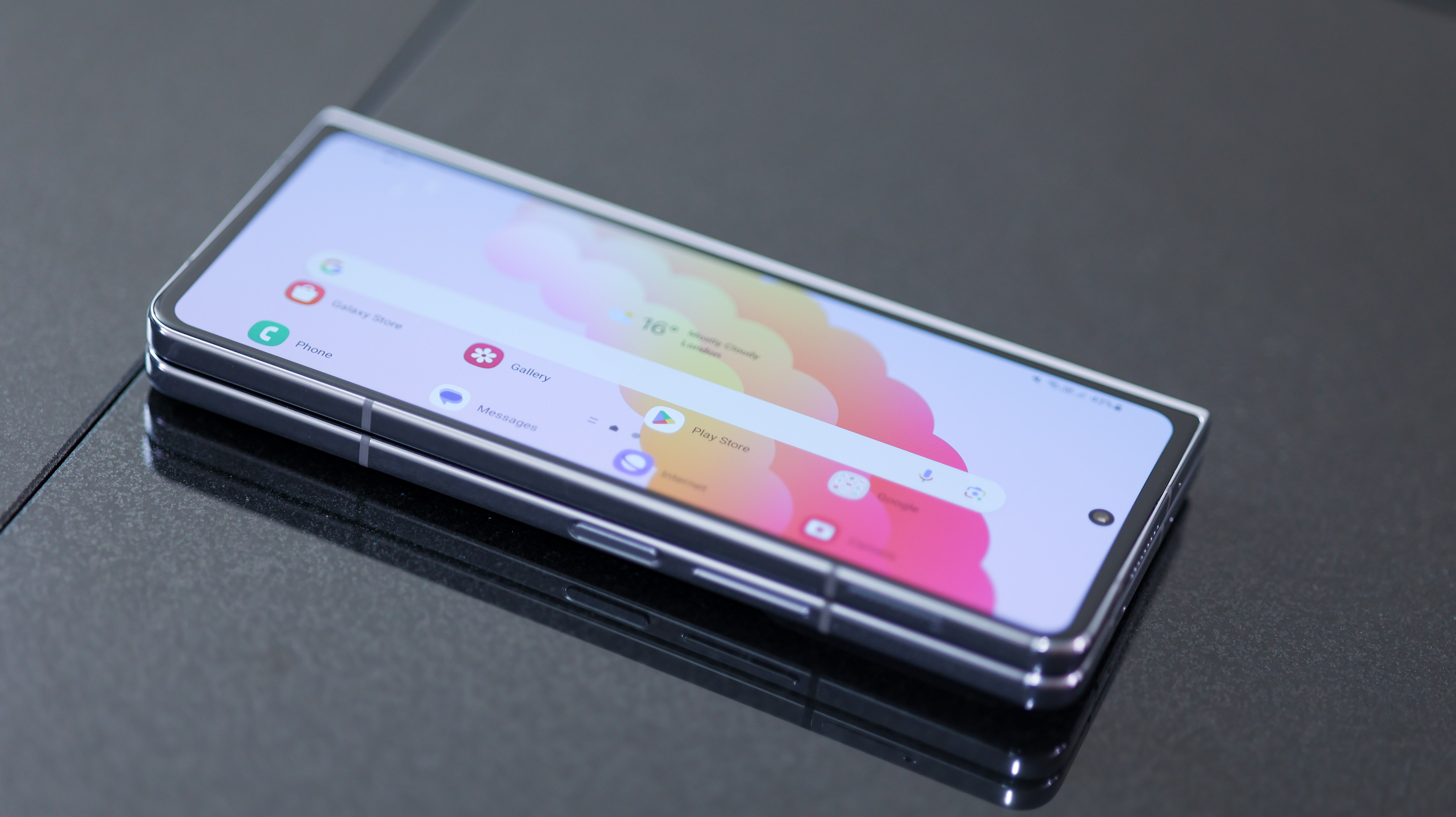
Flex Mode is also a great feature. Half-fold the phone, and the UI will either push your content into the top half of the screen, or a little icon will appear, prompting you to choose how that app is handled when the phone's half-folded.
With S Pen support, the Z Fold 5 is the only foldable available in the West that works with a dedicated stylus (other than the Z Fold 3 and 4). While the crease detracts slightly from the experience – no one wants to write on a bumpy canvas – it's excellent to have a feature that makes use of the larger screen other than a split-screen view, which is as far as some foldable makers are pushing their big-screen experiences at the moment.
The S Pen isn't just great for notetakers, it's also excellent for masking in apps like Lightroom. And matched with the Z Fold 5's large, 7.6-inch display, photographers who enjoy a bit of on-the-go editing will love it.
The Samsung Galaxy Z Fold 5 doesn't offer expandable storage, though it's available with a starting capacity of 256GB, and that can be bumped up to 512GB or 1TB. Whichever capacity you go for, it's matched with 12GB RAM, and up to an additional 8GB of dynamic RAM, which Samsung terms RAM Plus.
Samsung Galaxy Z Fold 5 Verdict
While Samsung's Galaxy Z Fold upgrades are modest for 2023, a combination of factors make sure it's still the victor in the battle of the big-screened, book-style foldables.
Far from perfect, the Z Fold 5's cover screen is too cramped, its design feels clunky, and its crease is very pronounced – especially compared to some foldables launching in China. It's also prohibitively expensive, and its cameras are what we'd expect to find on a premium midrange phone.
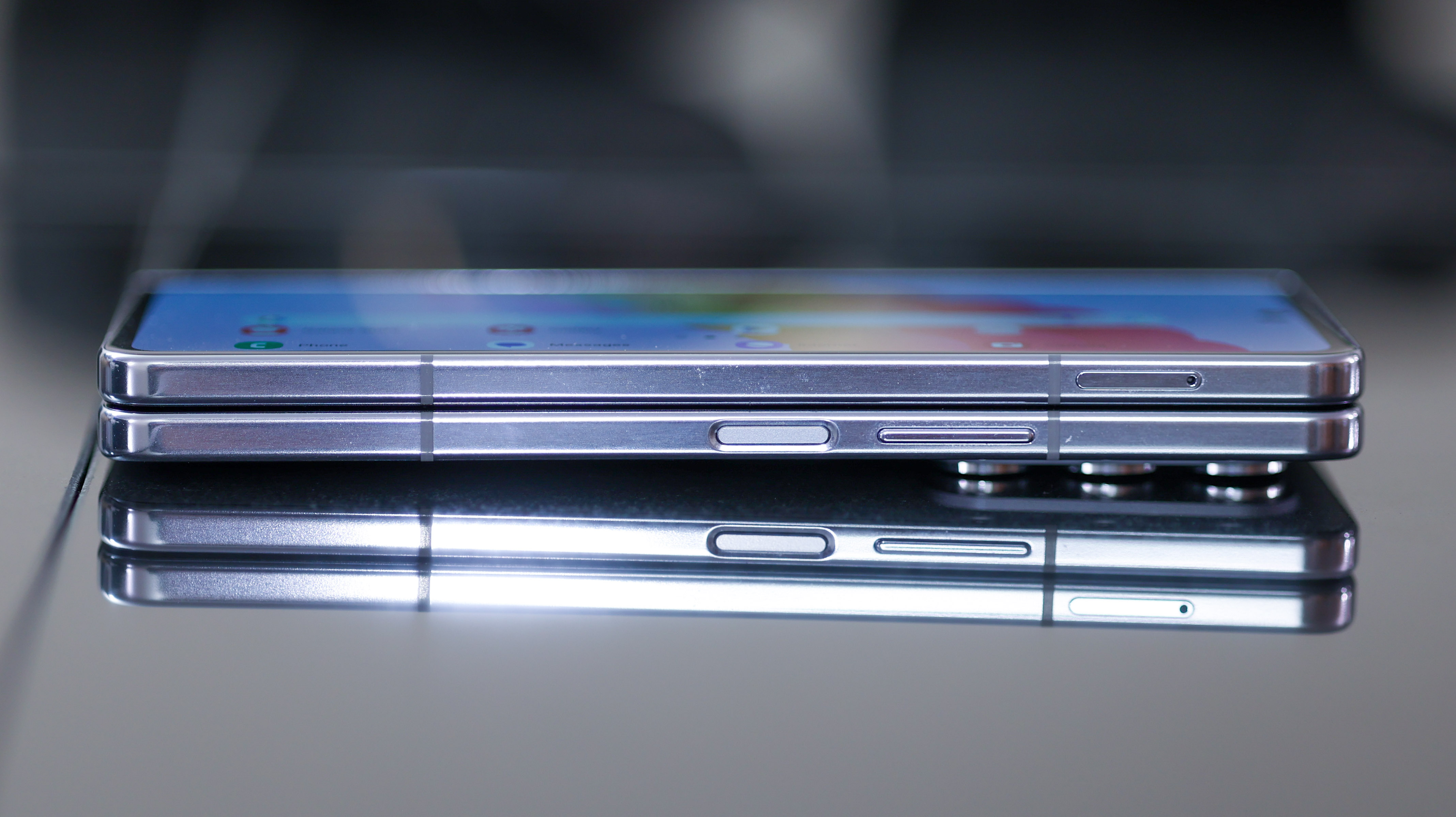
How can a phone be so flawed and still so great? Simply put, foldables are new. While traditional slab-style phones have had a couple of decades to find their feet, smartphone makers are still trying to figure out how to eke the best out of flexible screen tech. Add durability concerns and hinge design to the mix, and it's clearly, a tough nut to crack, with Samsung (the brand behind bendy screens) being the lead nutcracker.
And so, thanks to the Z Fold 5's highlights – water resistance, feeling durable, unfolding totally flat, S Pen support, best-in-class software optimization, quality displays, plenty of power, versatile camera software, and more – if you're going to buy a foldable in the West right now – the Z Fold 5 is the one we would recommend.
Read more: If the Samsung Galaxy Z Fold 5 doesn't do it for you, check out the other best flip and fold phones
Basil Kronfli is a freelance technology journalist, consultant, and content creator. He trained in graphic design and started his career at Canon Europe before moving into journalism. Basil is also experienced in video production, independently running the YouTube channel TechEdit, and during his time at Future, he worked alongside the Digital Camera World team as a senior video producer.
